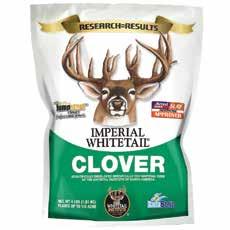Scott invented antler-growing food plot industry using revolutionary research. ❚
Scott invented antler-growing food plot industry using revolutionary research. ❚
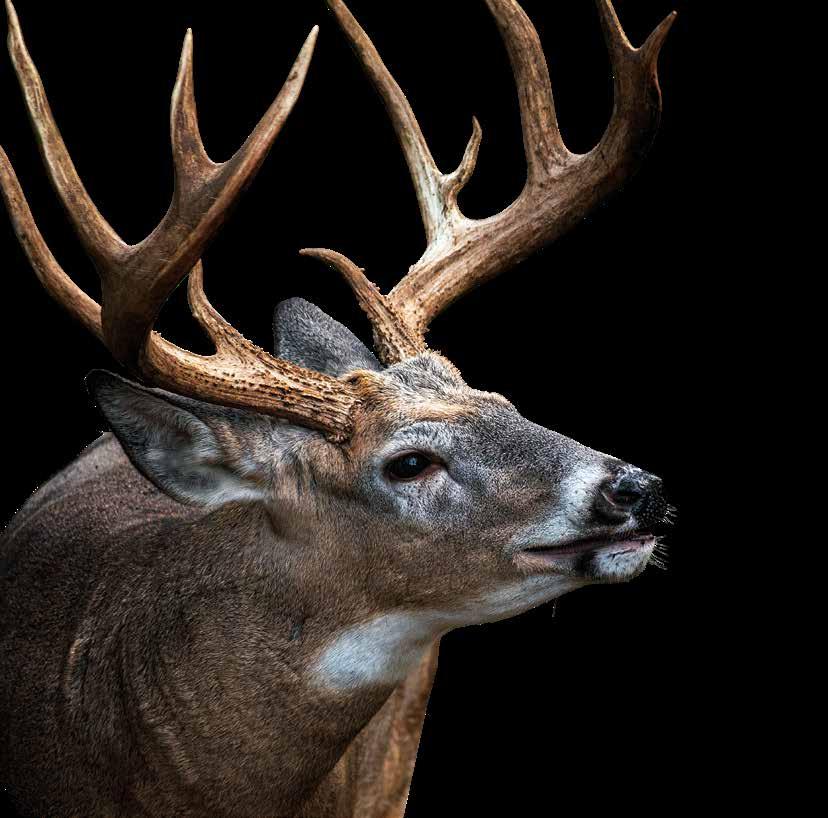

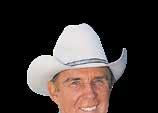



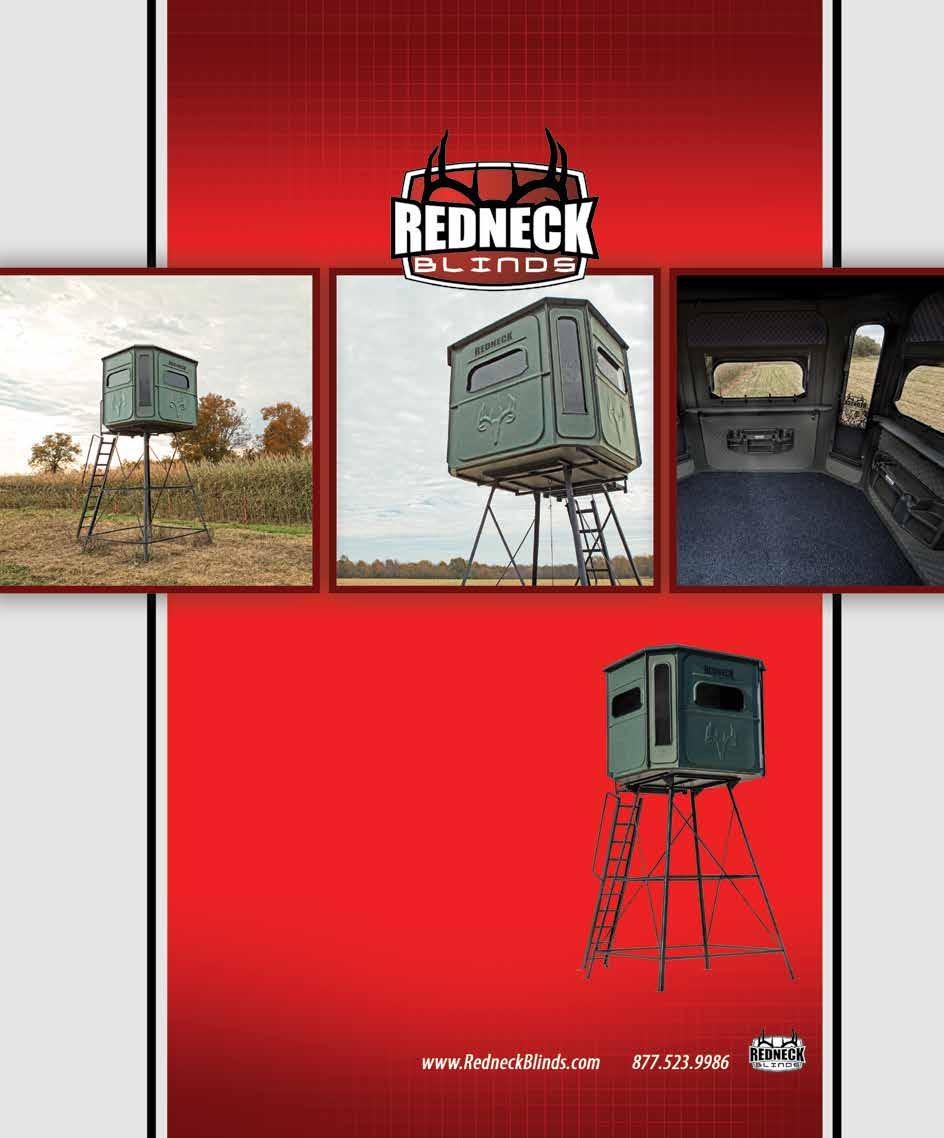
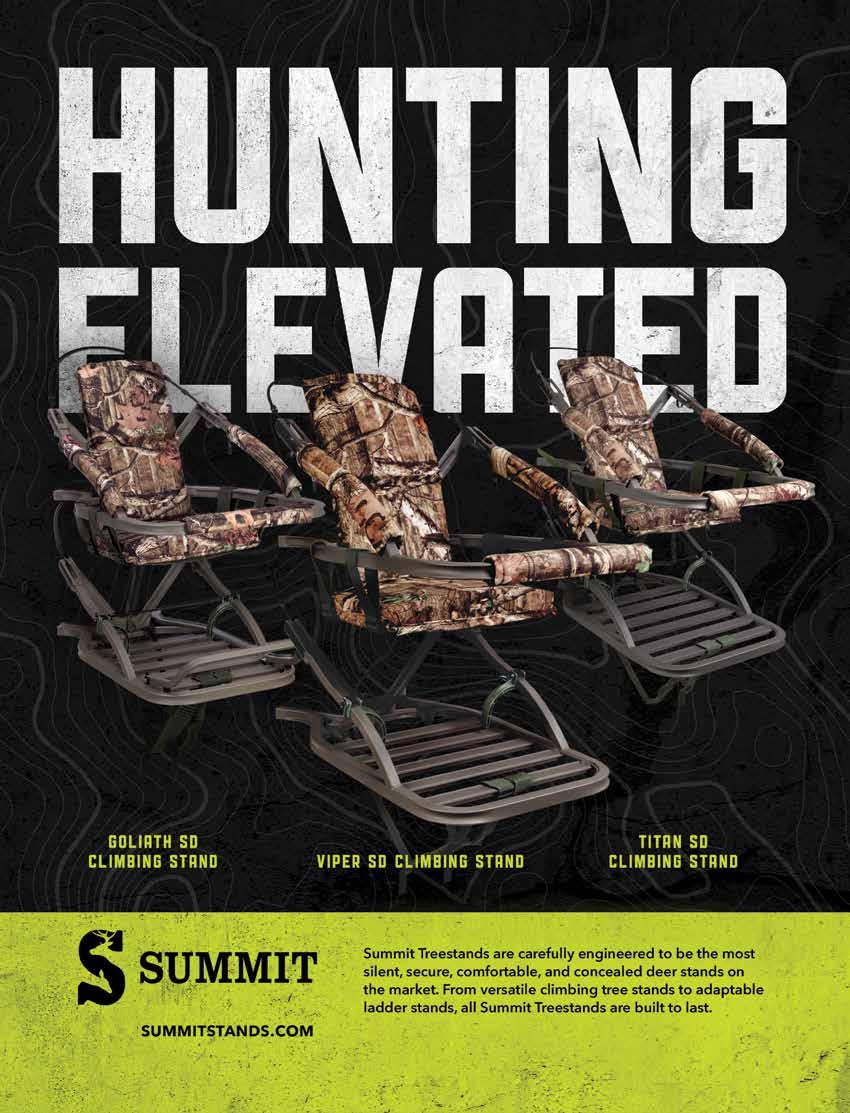


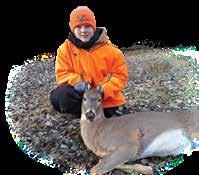
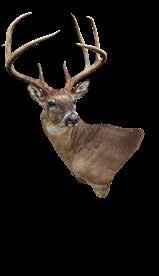


Scott invented antler-growing food plot industry using revolutionary research. ❚
Scott invented antler-growing food plot industry using revolutionary research. ❚
















Selling a business can be gut-wrenching, especially when it’s a business you have nurtured from the tiniest seed of an idea. In my case, that’s a literal statement.
So when I decided to sell the Whitetail Institute of North America after more than 30 exciting years of groundbreaking innovation and hard work, it was with a certain amount of trepidation — but mostly determination — to find the perfect fit with a new owner. The owner had to share our values and goals, and would maintain the outstanding reputation we had built. And of course, it would maintain the quality of our products. In short, we wanted a guardian of the industry we had painstakingly pioneered.
And that’s exactly what we found with Pradco Outdoor Brands. Remarkably, Pradco was an old friend from my earliest BASS/Bassmasters days, when it represented and manufactured some of bass fishing’s finest lures. Today, it’s a well-known name in the outdoor world. In fact, Pradco is the largest company in the world that manufactures and markets major hunting and fishing brands under one banner. In hunting, think Moultrie, Summit, Code Blue, Texas Hunter, Knight & Hale and others. In addition, the company’s headquarters is in Birmingham, Alabama, an easy 90-minute drive north. We simply could not have paired with a more perfect company.
Now, as a family member of Pradco, we know we’re so much more than an impersonal acquisition. We are passing the torch — entrusting Pradco to continue a trailblazing industry that has changed the world of deer hunting and whitetail management and conservation. It might be new ownership, but customers will find little change. The same great sales consultants are ready to answer any questions. And of course, there will be the same great products and continuing research.
William Cousins has deservedly been moved to general manager, and I couldn’t be prouder. William was my first Whitetail Institute employee. He worked on my ranch in Pintlala, Alabama, as a college student, and even then, he was a knowl-
edgeable farmer and avid deer hunter. Also, our headquarters remains on my rural property in south-central Alabama. We are all family.
So much has happened since I started the Whitetail Institute of North America in 1988 —and not just to the company but to the deer hunting world. In a previous issue, Matt Harper, a former employee and current field editor, wrote, “Ray was never satisfied with the status quo.” I guess that pretty much sums up most of my life, especially in my business endeavors. Sitting still sure doesn’t move you forward.
Plus, back in the mid-1980s, there was nothing to like about the status quo of deer hunting in Alabama unless you were satisfied with sparse herds of inferior whitetails. Yet there we were, trying desperately to make the best of a mediocre situation.

Then one magical day, I watched the deer browsing on the buffet I had planted on my biggest field. Time and again, they stepped over traditional plot mixes to get to the new clover I’d planted, recommended by my man at the seed-and-feed store in Montgomery. That’s exactly how and why my search for Imperial Whitetail Clover began. Ultimately, the development of deer-specific forages helped launch a learning curve about whitetails, protein, nutrition and management that continues today.
As soon as word of the success of Im-
perial Whitetail Clover spread, we were deluged with immediate, specific and emphatic feedback of what deer hunters and managers wanted and needed. Our mission was clear: Listen to our customers. Imperial Alfa-Rack, for well-drained soils, followed as quickly as it could, allowing for full research, development and testing in the real world. That was followed swiftly by Imperial NoPlow, which is still one of our best-selling products, and enabled folks without the time, inclination or equipment to plant a food plot.
More products have followed for various conditions, all carefully researched and tested. That’s an expression of saying “yes” to innovation, improvement and a better whitetail experience for all. Intensive field research across the northern and southern regions of the country produces the best forages for deer.
Now, the Whitetail Institute is a proud Pradco company, and I know it will continue to innovate, thrive and serve hunters and land managers with the finest products and services.
So it’s with great confidence the Scott team hands the reins to the Pradco team to proudly rest under the umbrella of one of the most prestigious outdoor companies in the country.

A New Soil Amendment for Food Plots
“This was a brand-new piece of property we got near the end of summer. With little to no time to properly amend the soil, Impact was the perfect solution to get us through this first year while we properly adjusted the pH. The results speak for themselves.
I am a believer in Impact!”
Jason Say, PennsylvaniaPHOTO BY JASON SAY ■ by W. Carroll Johnson, III, PhD. – Agronomist and Weed Scientist INSET PHOTO BY W. CARROLL JOHNSON, III
To a food plotter, the definition of frustration is looking at a subpar plot, even though you spent time, money, blood, sweat and tears doing everything “right,” according to the experts.
In reality, many factors influence the success of growing crops, which occurs in the real world, not a testing laboratory. Soil pH is a critical factor that can differentiate a great plot from a so-so plot. You’re probably saying, “Yes, I know; lime, lime, lime, right?” Yes, if your soil is acidic, as plotters commonly use lime to neutralize the soil. But is lime always the answer?
Managing soil acidity remains a challenge for Whitetail Institute customers. Acidic soils inhibit crop growth by reducing the availability of essential elements (nutrient starvation) and increasing the availability of aluminum to toxic levels (poisoning). Acidic soils are buffered by soil amendments based on carbonates, oxides, hydroxides or silicates that chemically neutralize acidity. Those compounds are usually combined calcium, magnesium or potassium. Although those are essential elements for plant growth, their role in correcting soil acidity is as a carrier of the compounds that chemically buffer (carbonates, oxides, hydroxides and silicates). Limestone is a carbonate and is present as calcium carbonate, magnesium carbonate or a blend of both. Limestone occurs naturally, which makes this material cost-effective and commonly used to neutralize acidic soils. Conventional agriculture depends heavily on limestone to manage soil acidity.
Although limestone is the preferred and standard material to neutralize soil acidity, the large volume (tons per acre) of bulk limestone needed to neutralize soil acidity presents a logistical challenge. Limestone is not readily available in some locations because of the absence of large-scale commercial agriculture in those regions. Additionally, access to leased property quickly changes. Food plot locations might also be remote and inaccessible by large agricultural equipment, preventing you from fully achieving return on the investment
when used at a short-term hunting property. Essentially, this is because lime neutralizes soil based on physical contact, and it takes time — months if not longer — for lime to fully integrate into the soil. Therefore, an alternative to bulk limestone would serve customers who manage food plots at remote sites or have short-term access to a hunting property.
Impact is a new sprayable soil neutralizing treatment for specialized circumstances, such as those mentioned, in which you need quick neutralization or can’t get large equipment to a targeted plot. As a sprayable material, Impact solves logistical problems at food plot sites that are inaccessible or when limestone is not available. Because Impact is sprayable, you can easily transport it on a UTV or via a handtype plot sprayer to remote sites. In addition, Impact is quick acting, and forages immediately respond to the buffering and starter fertilizer qualities of the product. In short, problem solved.
“This product is revolutionary in many situations,” said William Cousins, general manager of the Whitetail Institute. “You can have great food plots your first year. For example, it’s fantastic for those areas that you just can’t logistically get bulk lime to the food plot location but want to have a top-notch food plot. Even in situations where the soil is acidic and you were unable to lime well in advance of planting, Impact will bridge the gap until the lime you did apply has time to take effect. This
nual forages are planted. Being sprayable, Impact has undeniable convenience. Impact is water-soluble and readily enters solution in a spray tank.
Another benefit of Impact is the starter-fertilizer aspect of the compound. The formulated product contains nitrogen (in the form of urea) and potassium. Both are essential plant elements and are readily available to forage crops.
To demonstrate the benefits of Impact, the Whitetail Institute chose a site in Upson County, Georgia, and used Impact in the establishment of the cool-season annual mix Imperial No-Plow. The property is in the piedmont of Georgia, where the soil is fine-textured clay. The site was previously in bahiagrass, without any recent liming or fertilization. Access to the site was a steep, narrow logging road. Pre-plant soil testing indicated the soil to be highly acidic and deficient in all essential elements. The food plot was about 0.8 acre and divided into three strips with different pre-plant treatments; Impact (25 pounds per acre, mixed with water and sprayed), pelleted dolomitic limestone (1,000 pounds per acre) and nontreated. The site was fertilized with 10-10-10 at 600 pounds per acre. After fertilization and treatment with the soil amendments, the food plot was harrowed and then seeded with No-Plow. Three weeks after planting, soil samples were collected and analyzed, and these are the resulting data:
Compared to the nontreated plot, with a
is a real game changer.”
The active ingredient in Impact is K2O, an oxide that chemically neutralizes acidic soils. The chemical reaction of the oxide component is quick and typically sufficient for one season, especially when an-
soil
of 5.5, the
of soil treated with Impact was raised to 5.8. When compared to pelleted dolomitic limestone (pH 5.7), Impact was slightly more effective in buffering the acidic soil. When you remember the additional application challenge of

1,000 pounds of pelletized lime versus simply spraying Impact, the benefit of even .1 increase in pH is significant. Additionally, Impact-treated soils had significantly higher amounts of potassium than soils treated with pelleted limestone or those that were not treated.
Additional trials were conducted with Impact in southern Georgia on a food plot planted with Imperial Oats Plus. Forage quality analysis was conducted four months after seeding Oats Plus. Impact at 12.5- and 25-pounds rates per acre improved the relative forage quality and crude protein in forage oats compared to the nontreated plots. Similarly, Imperial Oats Plus grown where Impact was sprayed at both rates had similar forage quality measurements compared to plots treated with bulk limestone. Dry-matter yields of Oats Plus were improved by Impact applied at 12.5 and 25 pounds per acre compared to the nontreated plots. Across all parameters measured,
those data indicate Impact improves forage yield and quality over nontreated soils.

Impact is simple to use and versatile. It can be sprayed before seeding or on emerged forages, up to two applications per year, which might be necessary if soils are highly acidic.
The water solubility of Impact might cause shorter-term benefits if rainfall is excessive after application or if applied to coarse-textured soils (sands) that are prone to leaching. In contrast, experience has shown that the benefits of Impact are sustained for a longer period on fine textured soils (loams, clay) compared to coarse-textured sandy soils. Multiple applications of Impact might compensate for leaching conditions.
In summary, soil pH is critical for food plot success, and although limestone application remains a recommended practice, there are situations in which it might not be the best option. Impact is a sprayable


soil amendment — an alternative well suited for sites where limestone applications are not feasible or when quick buffering of acidic soils is needed.
“As a sprayable material, Impact offers many logistical advantages,” Cousins said. “Impact improves forage growth and quality and results in a more productive and attractive food plot, improving your deer management and hunting experience. We at the Whitetail Institute think Impact is a game-changer. Food plotters no longer have to suffer through inferior plots while their soil slowly improves from liming or if liming is not an option. Using Impact allows our customers to have quality food plots each season.”



It’s one thing to tag your biggest buck ever. It’s quite another when that buck is the result of years of careful land and deer management. Add the fact that the hunter had a long history with the deer, and that the buck was not only his largest whitetail but one of the biggest bucks in state history, and you have a story worth telling.
That happened to Wayne Edgeworth the morning of Jan. 17, 2020. That day, he tagged a buck he’d named “The Gollywhopper,” an 8-pointer that would be one of the largest bucks in the Alabama record book. It’s rare that a 4-by-4 cracks the 170-inch minimum to make the Boone & Crockett all-time record book, but Edgeworth’s buck did that with room to spare. The towering tines and incredible beams of the Gollywhopper netted 175-⅛ inches, a score that placed it at No. 3 in the state’s typical record book and made it the highest-scoring typical killed in the Yellowhammer State since 1993.
Obviously, that’s an incredible whitetail, but the background story is more satisfying. Edgeworth, a 65-year-old retired plant manager, has been a passionate deer hunter his entire life. But his love of the sport reached a new level when he bought a 210-acre property in Marengo County.
“It was adjacent to a property owned by a hunting club I’d been a member of,” he said. “When it came up for sale, I jumped at the chance to buy it and make it my own.”
Edgeworth was serious in his quest to pursue the best management practices for his new paradise.
“I went to Quality Deer Management
Association meetings and seminars, wanting to learn as much as I could about managing and hunting the property in the best way,” he said. “One of the first things I did was create food plots, which I did with a bulldozer. I created primary and secondary roads that led to 3- to 5-acre plots, one on each 40 acres of the property. I planted all the standard stuff for this region; wheat, grain sorghum, and lab-lab. And of course, the deer ate it, but it didn’t seem like I was accomplishing much.”
That changed for Edgeworth during a chance meeting with a Whitetail Institute employee.
“I was having breakfast at a local restaurant when a guy pulled into the lot with a Whitetail Institute sign on his truck,” he said. “I went up and introduced myself to Wayne Crocker, and we got to talking about food plots and deer management. Wayne asked if I’d been planting any clover, and I said I had not. He helped me design a program for getting it started, and I bought the seed from him.”
The results, Edgeworth said, were almost immediate.
“Before I started planting Imperial Whitetail Clover in 2005, the body weight on a 4-½-year-old buck was 185 pounds. Only a year later, that average had jumped 10 pounds, and two years later, the average weight of a mature buck was more than 200 pounds, which is a really big deer in Alabama. Even better, the does and fawns just flocked to those plots. Imperial Clover was a game-changer on my property.”
But clover was also tough to maintain during the hot and frequently dry Deep South summers, Edgeworth said.
“The heat and lack of rain really made
clover a lot of work,” he said. “After several years of trying to have good clover for the hunting season, I switched things up a bit. I started planting annuals (Imperial Oats is a great choice), and then overseeded that with clover as summer faded and fall came. The clover was just coming up about the time deer season ended, but that meant I had really nice clover in spring and early summer, when the does were having fawns and the bucks were starting their antler growth.”
Although growing and maintaining clover didn’t seem the best choice for Edgeworth’s property during hunting season, he had a clever plan for optimizing opportunities for harvesting a buck.
“While I gave the main portion of these plots to the annuals, I started planting Whitetail Institute’s Edge on the corners of the plots, next to the woods,” he said. “Edge has different varieties of alfalfa in it, and the bucks and does would just hammer those portions of the plot where I’d planted it.”
Those Edge plantings would be the key to killing Edgeworth’s buck of a lifetime.
As noted, Edgeworth’s 2019-’20 season resulted in not just a whopper buck, but a Gollywhopper, the name he’d given to a giant 8-pointer he knew well.
“The first pics I had of him were as a 3-½-year-old,” Edgeworth said. “He was nothing really special then; just a pretty 8-pointer that only showed up on cameras at night. The next year, he was still a really nice main-frame 8-pointer, and because of his age and pretty rack, I put him on my hit list. I try to shoot bucks only 4-½ or older here, and he qualified. But

Wayne Edgeworth shot this 8-pointer, which is one of the largest bucks in the Alabama record book. Edgeworth’s buck netted 1751/8 inches, a score that placed it at No. 3 in the state’s typical record book and made it the highest-scoring typical killed in the Yellowhammer State since 1993. He credits Imperial Edge for bagging this monster buck.

I was in the blind in full dark, waiting for the woods to wake up. Finally, it was light enough to shoot, so I put my .300 Weatherby Mag. up on the sandbags. I was watching the corner of the field where I had that Edge plot when a little doe walked out in it and started to feed. Right behind her was the Gollywhopper, and he looked like an elk behind her. He was just huge. Well, I got my shoulder up against the rifle and tried to put the scope on that buck, and I was just a wreck, as I was shaking so bad. The cross-hairs were behind him, above him, in front of him — just everywhere but where I needed them to be.
he remained nocturnal, so I never had an opportunity.

“The next year, he absolutely exploded as a 5-½-year-old. He was still a huge 8-pointer, but with a crab claw on one side. I hunted him hard that whole season, but not only did I never see him, I never got a daylight picture of that buck. The next year, he dropped the crab claw, but his tines were even taller, and he’d put on a ton of mass — just a huge buck. I run 12 trail cameras on the property, and I kept moving them around, trying to find a place he liked to move in daylight. But I never got a daytime pic of him.”
Before the 2019-’20 season, Edgeworth started getting pics of Gollywhopper, and the buck was better than ever.
“He’d put on a sticker on his right side and was just a giant,” he said. “I knew he was 7-½, and I wondered if he’d start going downhill, and that maybe I’d never get to hunt a deer better than him. He was absolutely driving me nuts. He was all I could think about. I never ask the Lord for anything material, but I told him if he let me kill that buck, I would do it for his glory and take my testimony wherever the deer took me.”
On the morning of Jan. 17, 2020 Edgeworth got up to hunt, but earlier than normal.

“I usually let first light hit the woods and then I slip quietly into whatever stand I think is best,” he said. “But that day, I got up earlier than normal and rode my ATV in the darkness down the trail to one of my shooting houses. I was in the blind in full dark, waiting for the woods to wake up. Finally, it was light enough to shoot, so I put my .300 Weatherby Mag. up on the sandbags. I was watching the corner of the field where I had that Edge plot when a little doe walked out in it and started to feed. Right behind her was the Gollywhopper, and he looked like an elk behind her. He was just huge.
“Well, I got my shoulder up against the rifle and tried to put the scope on that buck, and I was just a wreck, as I was shaking so bad. The cross-hairs were behind him, above him, in front of him — just everywhere but where I needed them to be.”
Finally, Edgeworth pulled back from the scope and talked to himself.

“‘Wayne,’ I said, ‘if you’re going to kill this buck, you’re going to have to pull yourself together.’ So, I took a deep breath and leaned back into the scope. As soon as I got the cross-hairs on his shoulder, I took the shot. I knew I wasn’t capable of holding them long anywhere.”
At the shot, the buck trotted toward Edgeworth, and he thought he’d missed.
“Suddenly, he stopped for a second, and I could see him quiver and stumble a bit,” he said. “As he moved off the food plot, I got the cross-hairs on him and shot again. He got off the plot and into a little cutover next to it, and when I didn’t see him come out of there, I thought, ‘I think I’ve got him.’ So, I got down from the blind and went to the ATV. I drove over there and found him right away. I couldn’t believe the size of his rack, and his body was even bigger than it looked when I shot him.”
Edgeworth loaded the buck — with some mechanical assist from a lift — into


• Includes Persist Forb, WINA-100 perennial forage chicory and highly palatable grazing alfalfas
• Perennial — Lasts up to five years from a single planting
• Up to 44% Protein
Optimum Growing Environment:
• Soil Type: Well-drained soils to medium soils.
Hilltops and hillsides that drain well.
• Soil pH: 6.0-7.5
• ArrestMax herbicide approved
• Can be planted in spring or fall
the ATV and got it in his truck for the trip home. Those were probably the last moments the euphoric hunter spent alone with his deer. By the time Edgeworth arrived home and showed his wife the Gollywhopper, friends, neighbors and people he didn’t know had shown up to marvel at the incredible buck.
“After a while, people started guessing what he’d score, and I guess up to that point, I really hadn’t thought about it,” he said. “I knew I’d be thrilled with anything that made 150 inches, and I knew he had that with room to spare.”
Eventually, curiosity got the best of Edgeworth, and he called his friend Hale Smith, a measurer for the Alabama Whitetail Records program.
“Hale said he was at a meeting at their headquarters right then and to bring the buck down,” he said. “So that’s what I did. And Hale made a video of the scoring and posted it on YouTube. Well, that thing went viral. At last count, it had 1.2
million views.”
The buck has changed Edgeworth’s life, and although some killers of giant bucks tire of the publicity, the affable Alabaman is still riding high.
“Before this buck, I didn’t even know what a podcast was,” he said with a laugh. “Now I go someplace to show the buck, and people who don’t know me sure know the deer. It’s been a dream come true for me to make the financial investment of buying the land, putting in the sweat equity to make the hunting better and realizing the dream of killing the biggest buck I’ve ever seen. Everything just came together on that one special morning, and, well, let’s just say I’m blessed. When I told the Lord I would use the buck for his glory, I was serious, and I have tried my best to make good on that promise.”
Whitetail Institute is pleased to announce that Dr. Joyce Tredaway has joined our team as a technical specialist in weed science and agronomy.

Joyce is a native of Jacksonville, Alabama, graduating with a B.S. in agronomy and soils from Auburn University in 1993 and an M.S. in weed science in 1995. She obtained her Ph.D. in weed science from The University of Tennessee in 1998, and then started her career at the University of Florida as an assistant professor and extension weed specialist. Wanting to move closer to home, Joyce was later hired by Berry College, near Rome, Georgia, to start the plant science teaching curricula in the Department of Animal Science. She left that position while expecting her first son and stayed home with him. Joyce was then hired by the Alabama Cooperative Extension Service in Environmental Sciences on Sand Mountain. She later became the associate director of the Auburn University Sand Mountain Research and Extension Center and after three years was named director of the center. In 2015, she became an extension weed specialist for Auburn University. She stayed in that position until she returned to Jacksonville.
During her career, Joyce served as the major advisor for several M.S. and Ph.D. students, and on the committees of many M.S. and Ph.D. students. As the faculty coach of a team of graduate students from Auburn University, her team placed in the top four in a contest of field skills sponsored by the Southern Weed Science Society. Joyce has authored 29 articles in scientific journals, more than 149 peer-reviewed extension publica-
tions and 79 abstracts and proceedings.
Joyce has many years of experience in weed control in forages grown for livestock and wildlife. Additionally, she is very knowledgeable about new herbicide developments that might potentially benefit food plots. During her career, she was elected by her peers to serve in a leadership capacity on the Southern Weed Science Society Executive Board and
many committees related to weed science.
Joyce joins Dr. Carroll Johnson on the Whitetail Institute staff. Together, they will serve as technical specialists in weed science and general agronomy related to the management of food plots. Joyce can be reached at joyce@whitetailinstitute.com.














This powerful blend lets you create feeding and bedding areas at the same site — a situation that can lead to great hunting opportunities.

Most deer hunters recognize that two prime features — food and cover — are centerpieces of a whitetail’s life. Know what and where a buck eats and you’re edging closer to arranging a meeting with him. Figure out where he feels safe to bed and, well, tagging that buck is just a matter of putting in the time and hunting intelligently.
But if you really want to create a whirlwind of whitetail opportunity, find a spot that combines those qualities. Some of the best hunting setups I’ve had occurred when those critical needs combined at the same place. A couple of examples:
* In the central and northern Wisconsin woods where I learned to hunt, not much could beat a young clearcut for attracting a mature buck. Young saplings sprouting in the aftermath of a pulp harvest created thick cover bucks loved for bedding and also provided browse that big woods bucks craved.
* The farm country where I currently live is a mosaic of standing cornfields that offer bucks secure bedding and a handy food source. Several early-season bucks I’ve hunted have spent significant portions of time barely straying from a cornfield that fed and hid them.
* One of my favorite annual trips is a bowhunt to the plains of Kansas, where
milo is a preferred deer food at a certain stage of maturity, and the dense stems form a bedding area beyond compare. Bucks can bed in milo, stand up and start snacking immediately.
PowerPlant produces several tons of highly attractive, highly nutritious forage even during the hot summer months. It also provides a great edge that enhances a whitetail’s sense of security when feeding on nearby food sources.

ings in much of the country, PowerPlant is a unique blend. In addition to high-protein forage beans and peas, the blend includes sunn hemp and sunflowers.
The problem with those food/cover types is that the window to hunt them is often extremely narrow — and difficult. Although a good clearcut will last several seasons, standing corn and milo offer a whisker-thin time frame when they’re most attractive to deer and available to hunters. Worse, because of crop rotation cycles, there’s no guarantee the hot field you scored in the previous fall will be available the next.
I’m not sure if the folks at Whitetail Institute had those factors in mind when they created PowerPlant, but if they did, they deserve a deer hunting Mensa certification. Although the nutrient-rich food sources in PowerPlant feed whitetails for much of the year, other plant types form a towering cover source that deer use for bedding. Even better, a Power Plant plot can be manipulated to further increase food availability and hunting opportunity.
Designed for spring and summer plant-
“The beans and peas are a well-known high-protein food source that can handle some browsing,” said William Cousins, general manager of the Whitetail Institute. “The sunn hemp combines with the sunflowers to provide additional food and also a tall lattice for the peas and beans to vine up. That creates structure and bedding cover for deer and other wildlife.”
Cousins noted that PowerPlant is “a pretty forgiving mix.”
“It does well in thin- to medium-heavy soils,” he said. “We don’t recommend sites where the soil stays wet and mucky, so lowland sites are generally not a good bet.”
Naturally, proper soil prep is necessary for the best results, and applying lime to achieve a pH of 6.5 to 7.0 will ensure a healthy stand. For plots with grass problems, Cousins recommends one application of ArrestMax within a month or so of germination.
One requirement for success with PowerPlant is proper soil temperature.
“The biggest mistake people make is trying to get it in too early,” Cousins said.





Includes sunn hemp, climbing forage peas, true forage-type vining soybeans and small amounts of sunflowers.
Annual spring planting
Up to 38% Protein
Optimum Growing Environment: Soil Type: Well-drained to medium soils
Soil pH: 6.0-7.5
ArrestMax herbicide approved Planted in spring and summer
“The forage beans and peas need a minimum soil temp of 65 degrees to germinate properly. We tell guys to watch for farmers planting soybeans. Once you see those planters out, it’s OK to plant PowerPlant. This is a spring and summer planting, so the sooner it’s in, the better the growth, but warm soil is a must.”
In the lower Midwest, May 1 is a reasonable target date most years, with May 20 being the earliest recommended date in more northern climates. Southern managers should plan on an April planting.
Finally, Cousins warned that smaller plots are often not suitable for PowerPlant.
“While the forage beans and peas can certainly take browsing, they need to mature to that tri-foliate stage before they can handle too much pressure from deer,” he said. “Generally, I like to tell people if they have a ¼-acre plot or smaller, it’s best to go with something else. My ideal plot for Power Plant is ¾-acre or larger.”
Although the first hard frosts of fall will knock back production of the forage beans and peas, PowerPlant has more potential in the weeks and months ahead.
Naturally, the sunflowers and sunn hemp still provide the structure and security cover they always have, and with a little extra work, food production can continue.
“I’ve had great success coming back and discing lanes through PowerPlant and then putting in a fall planting,” Cousins said.
Imperial Winter-Greens, Beets & Greens, Pure Attraction or No-Plow are perfectly suited for planting in those tilled lanes.
Although obviously widening the window of feeding attraction, discing the lanes can also enhance hunting opportunity. Lanes can be created to funnel feeding deer toward stand and blind sites while keeping prevailing wind directions in mind. Lane width is a consideration when creating such a setup. It’s tempting to make the lanes wide to create more planting space, but widening them too much reduces the bedding attraction. Cousins recommended two to three disc widths, or 20 to 30 feet, as a good guideline.
Creating a one-two punch of bedding zone and feeding hotspot is likely to make a PowerPlant plot a desirable hunting loca-
tion. However, resist the urge to overhunt it, and always be mindful of wind direction, as well as your approach to and exit from stand and blind sites. Whitetails — especially mature bucks — value safety above all else, and it makes no sense to jeopardize a killer food plot by overhunting it.

I’ve learned a lot from some expert mentors, and one lesson that has stuck with me came from a savvy land manager who said, “One of my goals is to shorten the distance a buck has to walk between bed and feed. I keep that in mind whenever I’m creating habitat or a food source.”
As I reflected on that advice, it reminded me of the many fine hunts I’d enjoyed in the habitat types mentioned at the beginning of this story. In each case, I’ve watched bucks rise from their beds, walk a few steps and begin eating. PowerPlant has that potential, with the added benefit that you don’t have to wait on a logger or farmer to create the situation.
The Power (Plant) is in your hands. Why not use it?
We live in a connected world. Why should your Trail Camera be any different? Our proven HyperFire 2™ camera is now 4G LTE Cellular Enabled, allowing you to receive images from your camera almost anywhere in the world via email or through our Mobile App for Android® or iOS®. Cost effective data plans utilizing Verizon® or AT&T® are available directly through RECONYX and start at only $5 per month, with no long term contracts. With our Mobile App, you can create a custom cellular plan, manage images and check status or change camera settings from anywhere. All RECONYX® HyperFire 2™ Cameras are Made in the USA and are backed by a full 5 year warranty. RECONYX®, See What You’ve Been Missing…




















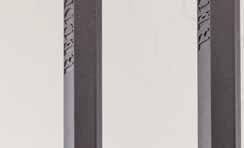





– NUTRIENTS SUCH AS calcium, magnesium, phosphorus, zinc, copper, selenium, manganese and vitamins A and D play active roles
The great mineral debate has raged for decades, but has anyone truly answered it? Here, an expert sheds light on common questions — and the truth.

Hunting has its share of controversy. Even within our ranks, we bicker about topics ranging from broadheads and calibers to hunting methods and management practices. Those arguments used to occur in books and magazines or at coffee shops and hunting camps, but the platforms available today provide endless soap boxes for pontification.
I believe everyone is entitled to an opinion, and good debate and verbal jousting are healthy and entertaining. But with the array of opinions on social media, discussions soon become a cacophony of rhetoric resembling a chicken house at egg gathering time. When you’re trying to find answers, that noise is distracting and sometimes misleading. Throw in a healthy dose of marketing from companies trying to peddle their wares and facts become as elusive as that double drop-tine, 200-inch swamp buck your buddy swears exists.
For example, hunters have for years debated the efficacy of free-choice mineral supplementation as a management practice for white-tailed deer. At opposite ends of the spectrum, you’ll hear, “It doesn’t help at all,” and, “Use it, and you will have so many giant bucks running around you’ll put your life in your hands getting to your tree stand.” Somewhere in the middle, you’ll find folks who aren’t sure it works, some who are pretty sure it works and everything between.
The truth can be tricky to identify, but with mineral nutrition, hunters can lean on several scientific facts to help decide. Those are based on nutritional research conducted during the past several decades on several species, including small ruminants and even whitetails.

Let’s try to understand some of the reasons behind the controversy. First, the all-natural crowd believes any management practices undertaken by humans are wrong — even unnatural. They figure deer and their environment should be left alone. That includes food plots, creating water holes, timber and habitat management, and even herd management. I try to be open-minded and see the allure of that ideology: Let nature be nature without human interference. But as with most ideologies, it doesn’t necessarily work in reality. Humans have changed the ecosystem, and not just by building cities and suburbs. We have cleared forests to produce food to sustain our species and have won the battle against competitive predators. Going all natural isn’t possible in today’s world because the world has changed. And this is not the start of an environmental rant.
Deer have been affected by this change but not necessarily negatively. Rather, in many ways, they have thrived in our new world and proven to be adaptable. In fact, they have increased in such numbers that we need to manage populations through hunting to maintain healthy herds. When we practice management techniques such

as food plots, habitat improvement and mineral supplementation, we do it to improve the overall health and quality of the deer that have adapted to live with us on farms, ranches, properties and backyards. Another reason behind the mineral supplementation debate lies in scientific or, more specifically, research, laws. The question of whether minerals really improve the health and quality of deer must be answered through research to eventually be considered as fact. Until that’s accomplished, a scientific purist will say the positive effects witnessed in mineral supplementation are simply anecdotal and not proven based on solid, fact-yielding research methodology. For example, if we set up an experiment to show the benefit of supplementing calcium in a deer herd, we would need to use this methodology. First, there must be control and test groups. The control group is the baseline and would not receive supplemented calcium, but the test group would receive supplemental calcium. The ideal methodology would include several test groups with varying levels of supplemental calcium to better pinpoint the exact level of supplemental calcium that produces the best results. Good research also requires
the removal of variables that might affect experimental results. For example, all the deer in the study — control and test animals — would have to eat the same diet with identical nutrient profiles other than calcium. That’s not that difficult to accomplish in a controlled environment, where deer are in a small pen. In fact, such research has been conducted in deer enclosures and showed positive results using supplemental mineral. The question, however, pertains to wild, free-range deer. It would be almost impossible to guarantee the absence of nutritional variables when studying wild deer. Additionally, there are other variables to consider, such as stress, age, gender and genetics, which would also be rife with variables.
So how can you conduct irrefutable nutritional research on wild deer? It would be almost impossible to remove the variables. Some would say that because you cannot prove its value scientifically, supplemental mineral cannot be recommended. That’s aside from the fact that mineral supplementation has proven beneficial in other ruminants, such as cattle, goats and sheep, and backed up by mountains of legitimate research. Also, we know that almost all soils are deficient in at least some form of
THE TRICK IS TO FORMULATE A PRODUCT THAT PROVIDES NEEDED NUTRIENTS BUT IS STILL ATTRACTIVE TO ENSURE PROPER CONSUMPTION LEVELS.– GAME CAMERA PHOTO These monster deer are congregating at a 30-06 Plus Protein mineral site. PHOTO BY MATT HARPER
macro or micro minerals and therefore lacking in the diet of deer.

Let’s get back to the obstacle of experimental variability. There is a way to get around those variables or at least greatly diminish their effects on the data: the size of the study group. The more animals involved in the study, the less variability will cause a false result. Think about it in terms of a political poll. If you only poll 10 people, you risk randomly selecting people with the same political views. However, if you poll 1,000 people, there is far less chance skewing the data based on who you pick. If the study group is 1 million people, the odds of getting accurate data are even that much greater. In research, there’s a term called P values, which are statistical data points that reflect the odds of accuracy. If the P value is 0.01, that means that there is a 99 percent chance the results of the experiment are accurate and duplicatable. The higher the test subject pool, the more likely to obtain a lower P value and, in turn, better conclusive results. So, to test the merits of mineral supplementation in deer, a huge study group would dilute variability and produce more accurate outcomes. How can that be done? More on that later.
The final cause of the mineral supplementation controversy pertains to the nature of the supplement. There are dozens if not hundreds of “deer minerals” on the market, most — if not all — of which claim two things: They attract deer and grow big antlers. However, the makeup of those products varies widely in nutrient profile. What attracts deer will not necessarily grow big antler or improve any other physical attribute. For example, salt will often attract deer but alone will not necessarily improve the deer herd. Deer crave sodium (that is, sodium chloride), and although they need it for certain functions, such as osmotic balance, salt does not directly affect antler growth. Nutrients such as calcium, magnesium, phosphorus, zinc, copper, selenium, manganese and vitamin A and D play more active roles in antler growth, immunity, lactation, skeletal growth and metabolism (body-weight gain). The trick is to formulate a product that provides needed nutrients but is still attractive to ensure proper consumption levels. Few examples of this exist. Con-
versely, there are many examples that are predominantly attractants only. Attractants are typically eas ier and cheaper to manufacture, and if deer dig a hole where that product was put out, a consumer thinks it must be working. The average person would have no way of knowing whether it provided any nutritional benefits. Therefore, many people think of a deer mineral as an attractant, making them skeptical about the positive nutritional effect of minerals on a deer herd.
I still haven’t addressed the question of whether deer minerals work. To do so, I’ll re-examine the causes of the argument.
I think it’s important to reiterate that today’s natural is not the same as it was 200 years ago. If you believe hunters and managers should let nature take its course, that’s fine, but understand that the landscape has changed. I won’t argue whether that’s good or bad but will say deer habitat is different than what it was and, in my opinion, we need to manage the herd based on those changes. But more important, we must consider that mineral supplementation is designed to improve the deer herd, not simply maintain status quo. The goal might be to produce bigger bucks, but that’s only done when you achieve a better overall deer herd, and improved nutrition plays a big role in that. Whether you care about big bucks or not, it’s difficult to argue with improving the general quality of the deer herd.
Regarding undeniable scientific proof, I want to pick up where we left off. As discussed, to get around those pesky variables, you would need a huge data set with years of in-field use. Only two products can really accomplish that: Whitetail Institute Imperial 30-06 and 30-06 Plus Protein. They have been around almost 30 years and have been used by thousands of hunters and managers. Imperial 30-06 and 30-06 Plus Protein have been used across multiple regions with widely different habitats, deer genetics and other variables. Through the years, they have consistently produced positive results, such as bigger

body weights, increased fawn survivability and, yes, improved antler growth. That enormous sample size along with repeated results all but removes the argument of variability. Some might argue that there could be other products that can do the same thing, but no other product has the sample size and repeatability to provide more concrete assurance in the expected results.
Finally, there’s the issue of attractants masquerading as nutritional deer minerals. Just because a marketing group gets liberal in its product claims doesn’t mean all product descriptions are misleading. If you’re not a nutritionist, it can be difficult to cut through the jargon, especially if you’re looking at a vaguely constructed tag. If a product is comprised mostly of salt or sweetener, it’s likely more of an attractant. If it contains higher levels of the nutrients we mentioned — calcium, phosphorus, magnesium and vitamin D — it at least contains the nutritional aspects of a true deer mineral. But even that can be misleading, as there are many other factors involved in the formulation of a good product.
Ultimately, you should base your decision on a company’s reputation and product results. We’ve discussed the unequaled results of Whitetail Institute’s mineral products. When you combine that with its reputation of science-based research and an industry-leading product development staff, your confidence in those products should be solid.
 ■ by Gerald Almy
PHOTOS BY JASON SAY
■ by Gerald Almy
PHOTOS BY JASON SAY
Slipping stealthily through the tall, green vegetation, I reached the camouflaged ground blind and eased inside. Cooling down from the hike, I slowly arranged every item of gear and settled back with my .50-caliber muzzleloader to see what the evening would bring.
Several does were already entering the plot, and I tried to calm my racing heartbeat. I had split the plot between Imperial Whitetail Clover and Whitetail Oats Plus. The forage preference of deer seemed to vary from week to week, but that afternoon, they were heading toward the clover. That would work perfectly.
I had waited a long time to hunt that plot, and the day of reckoning had finally arrived. Trail cameras had shown a 7-point 3-year-old using the plot during days with a northwest wind. Having approached from the south, I knew the deer wouldn’t scent me.
The buck was not particularly large, and he was not the type of 3-year-old I wanted breeding with local does. Given the chance, I planned to kill him before he mated with too many does. Can that help the overall herd? Probably not, but I like to do my small part. And because western Virginia allows two buck tags, I could still pursue a 4- or 5-year-old trophy with the second permit.
Everything was going perfectly. The does had not seen me approach and enter the blind. Heck, they couldn’t even see the blind because of the tall vegetation surrounding it, interspersed with strategic openings through which I could launch an arrow or .50-caliber bullet.
A few hours after I arrived, the sun started to settle behind the western horizon, and the 7-pointer eased into the clover. Carefully cocking the rifle, I waited for the perfect shot. It’s funny how you can hunt for decades and still get goose bumps when a buck walks into range. Controlling those emotions as best as I could, I squeezed off on the deer’s shoulder. As blue smoke filled the air, I saw the buck react before running to the edge of nearby woods.
I let my racing heartbeat slow, and then eased out of the blind, followed the blood trail a short distance and found the buck. I kneeled for a moment and admired the heavy-bodied whitetail. He had provided a thrilling hunt and plenty of venison for the freezer.
The hunt was satisfying for several reasons, including the way a new product had let me enjoy success. I had picked that food plot location a few years earlier because deer liked to mill around the area. They used my plots regularly, no matter what I planted. Unfortunately, I had not
fully considered how to approach the plot when I created it, as the best cover surrounding it was on the side where deer bedded and approached.
I had considered planting warm-season grasses or white pines on the open side to create a screen for cover so I could approach the blind undetected. However, before I had acted on those plans, I thought about Conceal, a new Whitetail Institute product designed to provide cover for just such a situation, among other uses.
“Conceal is designed to rapidly provide a thick screen, cover for food plots and bedding, hunter travel into stand locations or any other screening ideas a hunter can imagine,” said William Cousins, general manager of the Whitetail Institute.

The product worked as advertised. I planted it following the instructions and watched it shoot up almost immediately. I put in a strip from a stand of red cedars leading to the edge of the plot, about 20 to 30 feet wide. I also left a small area open at the end of the strip where I could set up a portable blind before hunting season.
The Conceal seeds germinated in days, and the plants grew quickly. Before I knew it, the stand was tall enough to hide someone approaching the edge of the plot and also conceal the blind with its mixture of sunn hemp and proprietary sorghums. My plants didn’t quite reach the 10- to 12-foot
height Conceal is capable of attaining in ideal conditions, but I’m shorter than 6 feet, so I didn’t need maximum height to shield my entrance.
The setup was perfect, but I needed the right wind conditions to hunt the spot. Finally, a cool front and northwest wind let me make my move. Patience and Conceal paid off.
Like many small-property owners who manage for deer, I realized early that habitat alterations and adding beneficial vegetation can help encourage deer to use my 117 acres more. And that’s particularly true for older bucks.
Changes can include hinge-cutting, planting food plots, planting shrubs or trees for security and food, adding cover for animals to bed in, and providing cover to give animals security as they approach a feeding site. I’ve also used screens to shield the view of deer on my property from neighbors and a county road. The vegetation additions have also allowed undetected access to areas I wanted to hunt, including food plots, fruit trees or other food sources.
I’ve used native warm-season grasses such as switchgrass, Indian grass and bluestem for that. I’ve also planted conifers, including white pines. Although those remain in my arsenal of management tools, I’ve added Conceal, the dynamite new product from the Whitetail Institute. It’s a great choice for landowners wanting to improve hunting success, keep more deer on the property and make deer feel secure (and thus more “killable”).
Conceal contains forage and grain sorghums selected exclusively by the Whitetail Institute to provide tall ground cover that can perform many tasks. It also includes sunn hemp, which makes cover even thicker and provides more security for mature bucks.

“Sunn hemp is a legume that has soilhealth benefits, grows rapidly and provides rigid plant structure to create tall, thick cover,” Cousins said.
The sorghum family of plants is well known for growing swiftly and providing dense vegetation. Mixed with sunn hemp, they create a perfect combination for land management and deer hunting.

“Conceal is drought resistant and will
• Designed to create thick cover, screens, funnels or other types of strategic plantings. Can grow 5-8 feet tall.
• Annual — Lasts up to 6 to 8 months
Optimum Growing Environment:
• Soil Type: Medium- to well-drained soils
• Soil pH: 6.0-7.5
• Sunlight: 6 hours of daily sunlight
• Best planted when soil temperatures reach 65 degrees
Conceal
actually grow well in sandy loamy soils to medium heavy soils,” Cousins said. “A pH of 6 or above works fine.”
Two of the most obvious uses for Conceal include creating cover to conceal a hunter approaching a stand and providing security for deer heading toward a food source through otherwise open terrain.
It can also be planted in strips or patches at strategic areas to entice mature bucks to stay on your property. Deer that stay on your property and feel secure are easier to kill and less likely to be shot by a neighbor when they’re 1- or 2-year-olds. The sorghums establish rapidly and grow quickly. They’re drought tolerant and can grow on fair- to medium-quality soils. Those traits make Conceal easy for even novice food plotters to grow. The quickness with which Conceal can be established is especially intriguing. You can use it to try various scenarios on a one-season basis to determine if you want to add more long-term cover, such as grasses or shrubs.
You can also use Conceal to create bedding cover and channel deer past your stand or blind. It can shield your plots from neighbors and adjoining roads from which people might see a big buck on your property. You can create a funnel to encourage deer to use a specific route by
planting a row along which deer will travel, leaving a small opening where you want it. Also, you can plant a strip of Conceal to connect bedding areas or channel travel between those areas, such as from mature woods through an open field to a cutover or orchard.
Mature bucks don’t like to cross open areas in daylight. But if there’s a strip of 8to 12-foot-tall vegetation to shield them, they will. But, because you created that cover, you’ll know where to locate stands depending on wind conditions and shooting lanes.
Conceal has many other uses (see the sidebar), but its basic functions were enough to make me order another supply for the upcoming season. It allows you to travel undetected, provides travel corridors and bedding cover, encourages deer to move more in daylight, and makes deer feel more secure and likely to stay on your land. It’s also easy to grow and provides deer with a tasty snack on their way to food plots.
It’s difficult to ask more from a product than that.
CREATING BEDDING COVER: We often think creating bedding cover involves hinge-cutting and piling brush in the woods to make secure, thick areas where old bucks want to bed. But many bucks are just as happy bedding in thick vegetation in fields. That’s especially true if there’s a food plot, orchard or other prime nutrition nearby.
Conceal is perfect for that job. Creating a warm-season grass bedding area would take two to three years. Conceal does it in a couple of months. That rapid growth lets you create new bedding spots as you open fresh areas for plots. And if you just purchased or leased a property, creating bedding cover where you want it before hunting season is extremely valuable.
This feature is especially important if you have limited woods and need to create cover in fields by planting blocks or patches of Conceal. Also, you can extend a strip from that block to a nearby food plot. Don’t stop at the edge, either. If you want to attract mature deer into the plot, run that strip into the plot, or have several strips enter it at different sides of the plot, letting you hunt in various wind conditions.

Approach route to other food sources: I have several large persimmon trees on my property. However, many are in semiopen areas where only young bucks and does typically use them during daylight.
I decided to fix that situation near a heavy-bearing tree where, trail cameras indicated, several nice bucks used the area. Moultrie trail cameras showed the deer were eating the persimmon fruits, but only at night. Planting a strip of Conceal from a bedding area to the persimmon tree encouraged several daylight visits. I haven’t killed any of those deer yet, but using Conceal paid off by encouraging more daytime activity. I plan to target one of those mature bucks this fall.
Conceal a blind: Manufacturers have made great advances in camo blinds, but those sometimes stick out in fields or next to a food plot. By planting a small patch of Conceal around an area where you want a blind, you can create natural cover that grows during summer. Further, deer will become accustomed to it. Just leave a strategic opening where you want to place the blind, with a few stalks carefully cut out or bent to let you fire an arrow or bullet.
Providing stand exit cover: This is probably one of Conceal’s most important uses, according to Cousins. Exiting a stand has always been problematic. But with Conceal, you simply slip out of the blind and walk behind the 8- to 12-foot-tall wall of cover.
Breaking up food plots: Longtime Whitetail News readers might remember a feature I wrote about breaking large fields into sections with different forages in each. By using Conceal to create strips of cover dividing those sections, you can make the plot more appealing to an older, wary buck. The deer can follow a strip and walk into the middle of a plot without exposing himself. After he gets to the end and steps out, he will be in the clear and, if you’ve planned properly, within shooting range.
During the rut, strips penetrating into forage will encourage a buck to fully enter the plot where does are feeding because he has cover leading into it. Since bucks might come from various directions, you can plant spokes, like a wagon wheel, entering the plot, letting deer approach from different areas in varying wind conditions.
Creating funnels: We’ve faced situations where a potential feeding area is just too open for a mature buck to use in daylight, with no approach route offering sufficient cover. Or perhaps you want to create or enhance a route connecting two prime doe bedding areas, which older bucks will travel heavily during the rut. Conceal will do the job. Maybe you have two heads of woods close together but no cover connecting them. Plant a strip of Conceal, and set up stands for varying winds at either end of the travel route. One bag of Conceal will plant a 35-by-300-foot strip.
Augmenting potential travel routes: I have a plot of Imperial Whitetail Clover with a stream leading to it. That creek would normally be a well-used travel corridor, but there’s no good cover bordering it. Only a few does and yearling bucks follow the creek. But next season, I plan to fix that and make the stream edge more attractive by planting Conceal and placing a blind along it. Later, I’ll add more permanent cover, such as edible shrubs and a few pines. The goal: Quickly create a travel route that’s attractive to older bucks.
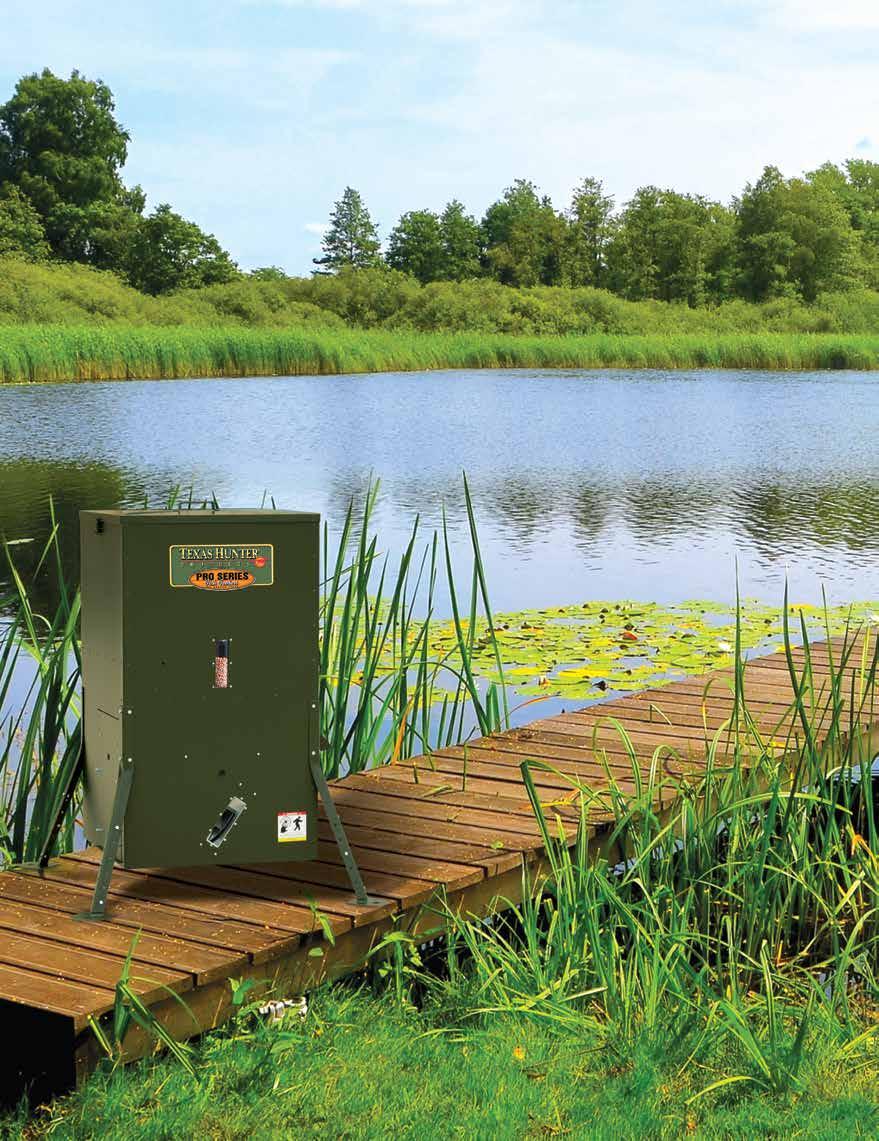





Weed control in food plots remains a persistent challenge. Weed species are diverse, and dormant seeds in the soil add an element of anxiety about what to expect. Herbicides are wonderful tools, but there is a limit to the benefits they can provide. Stated another way, weed species are numerous, and herbicide choices for food plots are few.
Proper timeliness is one of the keys to optimizing weed management with herbicides. Arrest Max and Slay can provide outstanding weed control, but the degree of performance is often linked to weed size. You can control smaller, younger weeds more effectively than larger, older weeds. In fact, the extreme connotation to that statement is usually true: Food plot herbicides do not control large weeds. Timing is everything.
Consider a weed complex that frequently infests customer food plots: smartweeds. There are three common smartweed species: Pennsylvania smartweed, swamp smartweed and ladysthumb. These species are closely related, in the genus Polygonum. In fact, the highly touted cover crop buckwheat is a species of Polygonum. Smartweeds can be controlled by Slay if applied at the correct stage of weed growth. When
Slay is applied at 4 fluid ounces per acre (the standard usage rate), it controls smartweeds no taller than 3 inches. Increasing the Slay rate to 6 fluid ounces per acre (the maximum rate) controls smartweeds up to 4 inches tall. When Slay is applied to smartweeds more than 3 to 4 inches tall, control is reduced. If smartweeds are flowering (as commonly seen in mid- to late summer), they will not be controlled by Slay or any food plot herbicide. If a food plot site has a history of smartweed infestation, it’s prudent that you make every effort to treat smartweed when it is 3 to 4 inches tall and be prepared, if necessary, to use the 6-fluid-ounce-per-acre rate of Slay. In food plot management, that must be a high priority. Otherwise, uncontrolled smartweeds will reduce food plot productivity and even survival.
When do smartweeds reach 3 to 4 inches tall? The only way to know is to scout (inspect) your food plot. That means walking the plot and critically examining the weeds and weed size — and not a cursory glance. As hunters, we were taught the importance of scouting for deer sign and patterns of movement. Although technology, such as trail cameras, helps, nothing beats observing and studying while creeping through
the landscape. Scouting for deer sign is ideally a year-round activity, and scouting food plots for weeds is no different. Scouting is a critical part of being a hunter, and scouting for weeds is equally important in managing food plots. Routine scouting of a food plot for weeds is also a good opportunity to monitor overall forage health and the presence of other plant pests, such as armyworms and aphids.
To be an effective food plot scout, it’s important to know the basic biology of troublesome weeds, just as it’s critical to know the biology of deer when patterning their activities. Smartweeds are warm-season weeds, meaning the seeds germinate and weeds begin growing in late spring and early summer as temperatures warm. Given the wide range in climate across North America, a broad estimation of when smartweeds typically emerge is lateApril through early-June. Smartweeds in Southern locations usually emerge during the early end of the range, but they emerge during the late end at Northern locations. That’s a generalized prediction and varies according to location and climate conditions. The only way to know for sure when smartweed emerged in your food plot is to put boots on the ground.
I chose the smartweed example because the frequency with which this weed infests customer food plots. What’s frustrating to customers and technical specialists are queries about smartweed infestations discovered during mid- to late summer. In these cases, smartweeds are typically blooming and too large for effective control with herbicides. If the question had been asked three months earlier, control with Slay would have been simple and effective.
We have lives beyond hunting, and time constraints are real. My suggestion is simple: Mark your calendar for early May 2021 to scout your food plots for weeds, and be prepared to spray. For me, mental notes no longer work, and if I don’t write down a periodic task, I’ll forget it.
To further maximize smartweed management, you need an improved understanding of the nuances of Slay. It has nearly equal performance when absorbed by weed roots as the seedlings emerge from the soil or through foliar (leaf) uptake when applied to small weeds. No other broadleaf herbicide for food plots has soil-residual activity like Slay, and that’s a distinct advantage Slay has over other herbicides. When used in conjunction with scouting, that knowledge will help food plotters better use Slay early in the season, when smartweeds can be effectively controlled, and capture the full benefits of the herbicide investment. If you expect smartweeds to infest your food plot but none are present when you scout, Slay applied during late spring through early summer will still control non-emerged smartweed through root uptake from the soil. That option is particularly appealing if your food plots are significantly far from home and you can’t make repeated scouting trips.

My local newspaper in southern Georgia has an embarrassing segment in the editorial section called “Rant and Rave.” It’s a collection of random, unedited and anonymous comments. Most come from subscribers seeking a (hopefully) fleeting moment of fame. Raves are rare, and rants are common — often with childish overtones. With anonymity-fueled courage, they launch with gusto fusillades of rants that rarely make sense. When writ-


A key characteristic used to identify smartweeds are the swollen nodes that are covered with a thin, clear membrane called an ocrea. This feature is also seen in buckwheat, a cover crop species related to smartweeds.


ing this article, I had to carefully construct the message so it would not be mistaken for a rant-and-rave submission. Accordingly, I boiled this article down to a concise message: Smartweeds in this article are a case study — an example to make a broader point beyond the management of
one specific group of weeds. I could have easily written the same article about common ragweed, crabgrass, wild mustard or dozens of other weeds. Regardless of the species, to effectively manage those weeds in food plots, you must target small weeds, and that requires attentiveness early in the




This
season. Plan on it.
The message is simple and straightforward but difficult to implement. I need to look in a mirror when preaching this.

If you own, lease or manage property for white-tailed deer, you’ve probably put some effort into cultivating food sources that attract them to critical locations. If you also hunt turkeys, or if you’re an outfitter who runs turkey hunts at properties where you conduct deer hunts, it’s wise to consider crafting your food plots to attract and hold both species.
This requires almost no additional effort during planting, as deer and turkeys have similar plantlife diets and everyday necessities. However, planning and forethought will help you achieve optimal results. Several considerations can boost your plot’s productivity for hunting and pure attraction.
In this article, we’ll explore insights from land manager and Whitetail Institute General Manager William Cousins and personal observations from longtime turkey hunting expert Brian Lovett. Hopefully, they will give you a greater understanding of what will make your food plots deer and turkey magnets.
The saying, “If you build it, they will come,” is true to an extent with food plotting, but you can increase your plot’s potential by locating it strategically. Of course, if you’re clearing trees and brush for a new plot, you can choose any location rather than using an existing one. Let’s discuss some tips that can help you select a good location.
“While turkeys sometimes use terrain much like deer do, they’re certainly less predictable,” Lovett said. “If your plot is located near potential roosting trees, it’s possible birds will use the plot frequently. Look at all aspects beyond the plot itself to determine why turkeys would be likely to use the area, and that’ll help you choose a good spot.”
For deer, start by identifying potential bedding areas, and then determine how deer might use terrain features to enter and exit the plot. Also, account for prevailing winds. You can set up a plot to have a stand or blind on the downwind side of the anticipated entry or exit point for an archery-close encounter.
For turkeys, prevailing winds are irrelevant, so although birds might enter and exit a plot somewhat unpredictably, they might be more susceptible than deer because you have more setup options. Your focus involves how to get a gobbler within 40 yards of your setup. If you make the plot 60 by 60 yards, you can place a ground blind in the middle. Then, any longbeard that pokes his head into the plot — whether he commits to your decoys or not — is well within shooting range.
Other shapes and configurations can optimize your plot for shooting opportunities at deer and turkeys.
“A lot of hunters like an hourglass-shaped plot or one that includes some other type of pinch point,” Lovett said. “You almost have to tailor your plot toward whitetail hunting even if you want to attract turkeys, too. That’s because, with turkeys, you generally have more setup options since the wind isn’t a factor, and because you can place a ground blind just about anywhere in the absence of cover and use decoys to bring birds to you.”
After you’ve selected a location, always take a soil test to ensure food plot success. Next, identify common denominators between whitetails and turkeys before you plant.
“Turkeys, in some cases, will eat practically anything they can fit in their mouths,” Lovett said. “They use many different forages, from soft masts to hard masts to insects to green vegetation. In terms of planting, Turkey Select Chufa has long been proven to attract turkeys. The tubers are easily scratched up and are sized perfectly for foraging.
“For year-round nutrition, Imperial Whitetail Clover is arguably the best. It greens up early in spring, a critical time when turkeys have fewer foods available, particularly in Northern climates. The first green shoots really attract the hens. Obviously, whether hens are ready or not, gobblers will be nearby, showing interest in breeding.”
Lovett also said clover expends well year-round for turkeys.
“During summer between mowings, it gets fairly tall and holds a lot of bugs,” he said. “Insects are critical food for young poults, as is the clover. They need the protein to grow. An insect-riddled clover plot is a natural draw for family flocks. As fall progresses, there are usually many food sources available, but as some begin to diminish, they’ll hit that clover again just like they did early in spring. It’s a terrific all-year forage.”
Of course, whitetails also love to forage on clover. Like turkeys, whitetails will hit it extremely hard during early spring through September. Often, it takes a back seat during the middle of the season, as other food sources become primary, but whitetails will eat clover all year, even pawing through snow to get it.
Years ago, my brother and I planted brassicas in a small 1/8-acre plot. We attracted some deer, but the area wasn’t a magnet, and we didn’t hunt it. The next year, I planted it with a clover and chicory mixture. I attracted more deer (including






~Protein-laced Imperial Whitetail Clover has gone through immense research and development and is scientifically designed for white-tailed deer. It thrives in cold and warm climates and provides nourishment for bone, antler and muscle growth and development. Enjoy up to five years of luscious clover after planting. This specially designed clover produces healthier deer herds. Imperial Whitetail Clover is also a choice forage for turkeys, and it holds insects critical to the turkey’s diet.

~Drought- and cold-tolerant Chic Magnet is a forage chicory with incredible attraction power for whitetails and turkeys. This perennial is extremely tender and provides up to 44 percent protein — ideal for herd health and antler growth. One planting can weather up to three years, and its RainBond coating increases seedling survival rate. Pair it with Imperial Whitetail Clover for a double-whammy perennial plot deer and turkeys cannot resist.

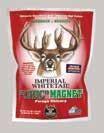
An annual nurse crop such as Whitetail Forage Oats can spice up the allure of perennials such as Imperial Whitetail Clover or Chic Magnet Forage Chicory. Its high sugar content and winter tolerance make it a great late-season forage for fall plantings. The cover it provides will help the perennial establish. Plus, it will grow from knee- to thigh-high, giving turkey poults and fawns additional security.

seven bucks) but constantly had turkeys on my trail cameras, too. That season, I bow-killed a fall turkey and a mature doe in the tiny plot. My results suggest that although clover is king, chicory has its place in a dual-purpose plot, too.
When you’ve chosen a location and prepared the soil for seeding, start with year-round nutrition in Whitetail Institute’s Imperial Whitetail Clover, and also consider mixing with Chic Magnet, which is a forage chicory deer and turkeys love. If you want to angle your plot a bit more toward turkeys, planting a dedicated area with Turkey Select Chufa can enhance its allure.
Cousins provided closing input worth considering.
“Whitetail Clover is certainly a great perennial, but I don’t plant a perennial in the fall without also planting the nurse crop,” he said. “I start by broadcasting fertilizer, and then I broadcast Whitetail Oats Plus as the nurse crop. I back the broadcast rate from 90 pounds per acre to only about 35
• High-quality chufa that attracts and holds turkeys. The nut-like tubers produced are scratched and devoured by turkeys.

• Perennial — Designed for late summer/fall food source
Optimum Growing Environment:
• Soil Type: Medium- to well-drained soils
• Soil pH: 5.5 - 7.5
• Sunlight: 6 hours of daily sunlight
• Best planted in late spring or early summer
to 45 pounds per acre. I’ll lightly drag the oats and fertilizer in, and then finish by broadcasting clover at the full seeding rate.”
Cousins’ strategy lets the oats reach a height where they provide some cover within the plot for turkey poults and fawns. He also suggested creating a “soft edge” around the plot for additional cover and security.
“When I’m spraying or mowing my plots in the spring, I like to leave 20 to 30 feet all the way around the circumference untouched,” he said. “Natural vegetation along with the oats and clover creates a soft edge with cover that makes good nesting
habitat for turkeys and other birds. It’s also great for fawns.”
Now that we’ve explored the topic, roll up your sleeves, and get to work. Create an environment where whitetails and turkeys coexist during feeding times. You’ll have the satisfaction of more shot opportunities while hunting and will also find enjoyment watching both species use an area you built just for them.


Food plotting has been a big part of my hunting activities for three decades.
I know my efforts have profoundly improved my hunting experience and success rate, along with the quality of deer on my property. In fact, nowadays, I enjoy plot work almost as much as hunting. One of the things I like best about food plotting is the learning process that never ends. With the evolution of food plot seeds, products and techniques, led by the Whitetail Institute, it just keeps improving. Hunters are connecting with the land more than ever before thanks largely to food plots.
Last year started as a dismal year in the whitetail woods. I canceled my annual spring work trip to my Upper Peninsula, Michigan, hunting property because of piles of lingering snow in early May. When I finally got there later in May, spring flooding was going full steam, and the seasonal road to my property had washed out and was impassable. My plans to replant my food plots were dashed. My largest food plot is five acres, and during my next trip in June, the entire western side of that plot was still under water from spring flooding. Some of the smaller plots were wet, too. I planted and fertilized what I could mostly with Imperial Whitetail Clover and revised my plans for more planting in late summer.
I traveled there again in mid-July, and the grass and weeds were so high I couldn’t spray the Imperial Whitetail Clover. I decided to mow the freshly planted plots and spray glyphosate over the dried areas I couldn’t plant to prepare those sites for an August planting. I had been mowing for years with an old modified lawn tractor, and a few minutes into mowing, the motor blew up, rendering the tractor into junk. I had actually been anticipating that, though, and was planning to buy a new commercial-grade zero-turn mower. This new mower cut down the plot perfectly.
Returning to my hunting property in mid-August, the Upper Peninsula was in the midst of a wet summer. There was still standing water in uncommon areas. The clover I’d planted in spring was growing, but the grass and weed growth was thighhigh, so I had to mow it again. I disked, fertilized and otherwise prepared the seedbeds in the unplanted areas and then seeded it with Imperial Whitetail Clover.
Just for kicks, I bought a couple of bags of Whitetail Oats Plus and seeded it with the
clover, mainly as a cover crop but also to choke out the weeds and hopefully spice up the plot. I seeded my small food plots with Secret Spot and No-Plow, which I’ve been using for years with good success.
I returned to my property for my annual bird hunting trip in mid-September and found the new oats and clover planting was looking extremely good, with lots of fresh green growth. Deer sign abounded, and all of my plots were getting hammered by whitetails.
I’ve learned that a good hunting strategy on my food plot-laced property is to hunt close to my cabin during my first hunts. Then, as my hunting pressure starts to affect those areas, I move deeper into my property, always hunting unpressured deer. Opening morning, Oct. 1, was a gully-washer, and my first evening hunt was cut short when winds cranked up, flushing me out of my tree stand before I was ejected. The next day was another washout with an all-day rain.
The weather finally let up the third day, so I hunted a stand that’s only a couple of hundred yards from my cabin. It overlooks a small food plot between a thick stream-bottom bedding area and my 5-acre food plot, which deer were browsing like crazy. As I developed my property years ago, things didn’t really explode until I added that big food plot. It doubles the deer population on my property when it’s in full production and was the tipping point in having enough forage to keep them there throughout fall.
A few does and fawns were the first visitors during that hunt, followed by a yearling spike and then a big-bodied 2-year-old fork. I’m not a trophy hunter these days, and because we can’t shoot antlerless deer at my property, I just target big-bodied legal bucks. With two buck tags for the Upper Peninsula, that means one buck must have at least three points on one antler, and the other buck must have at least four points on an antler. As such, the big fork was off limits. An hour later, I saw another big-bodied deer coming out of the swamp. He looked bigger than the fork, and when I counted six points on his noggin, I shouldered my crossbow, took careful aim and let one fly.
It was a quartering-away shot that looked perfect, so after a wait, I went after him. Following his trail of upturned earth for 75 yards surprisingly revealed no blood. Then I found a speck, which led to a drop and
then a spray. Scanning ahead, I saw him piled up. I’ve learned that some deer just don’t bleed much, but you must be diligent. That 6-pointer dressed out at 179 pounds and was later aged by the DNR at 3.5 years old. Incidentally, after tagging that deer, I returned to camp, got my sled and removed the deer from the hunting area with as much stealth and as little mess as possible, gutting him where I don’t hunt and burying the innards so as not to attract predators. Stealth after the kill sometimes pays big dividends, especially on smaller properties with limited areas to hunt.
The next day was a windy, rainy, snowy no-hunting day. The rain eventually stopped, but the wind was still blowing too hard to hunt from a tree, so I decided to hunt the ground blind where I had killed the 6-pointer two days earlier. That blind is dug into the side of a ridge like a bunker, so I call it The Hole, and it’s perfect in high winds.
Much like my first hunt at that spot, I saw some antlerless deer first. Several hours later, almost at midday, a nice buck marched through. Glassing him to make sure he was legal, when I counted eight points, I went into kill mode and lined him up for almost an identical shot as the first deer. He was walking around a stump along the edge of the food plot quartering away, so I aimed for the opposite shoulder and pulled the trigger. This time, the buck turned and ran back into the swamp, and I thought I heard him crash a short distance away. Taking up that trail 45 minutes later revealed a lot of blood immediately, and the wide, short blood trail ended at another 3-year-old buck. My season was finished.
My wife only hunts with a rifle and buys one tag. She also had a great hunt in November, culminating with another 8-pointer hanging from our buck pole. Because my main clover planting was lagging behind the norm, those Whitetail Oats Plus really paid off. Deer seemed to go nuts over those oats. Even though deer numbers in our area are at a modern low because of recent bad winters and high predator levels (wolves, coyotes, bears and bobcats), we still had good hunting at our little oasis in the big woods. Next year should be even better, and as the learning process continues, the future looks great.
COVID-19 has thrown health and government officials across the nation nasty curveballs for the past year as they battle this horrible pandemic. In a turn of events nobody could have predicted, it appears COVID-19 lockdown measures have helped increase hunter numbers across the United States.
For example, The Washington Post reported on Jan. 10, “Michigan saw a 67 percent hike in new hunting license buyers last year compared with 2019, a 15 percent increase in female hunters and moderate growth in many younger age brackets. The state also sold 46 percent more apprentice licenses, a discounted option that allows new hunters to give
the sport a try under the supervision of a mentor.” License sales also increased dramatically in Maine, Wisconsin, Montana, Pennsylvania and other parts of the country in 2020.
This positive news for hunter numbers helps build upon new ideas state agencies have been using to expose non-hunters to our sport. Emily Lehl, R3 (recruit, retain and reactivate) coordinator for the Wisconsin Department of Natural Resources, heads a program followed by many state agencies.

“When we started trying to recruit new hunters back in the mid-’90s, the department concentrated mostly on youth hunters,” she said. “After several years, we discovered a couple of things. One, most
of the kids involved in the program were from hunting families; not really the target audience needed to attract new hunters. And two, the participating kids from non-hunting families had no support network to continue hunting once they had passed through the program.”
Although youth programs remain an important part of the department’s R3 efforts, most of today’s focus centers on young adults. “We noticed an increase in interest from young adults who were looking at hunting as a means to procure organic protein for themselves and their families,” Lehl said. Many of those young adults were from urban backgrounds. They didn’t come from hunting families and were often several generations re-





My wife, Kay, gets up every morning at 5:30 a.m. and quietly prepares for her day at an area hospital near our home in Wisconsin. She never complains about being a physical therapist and treating patients who have contracted COVID-19. That’s her job — a job she has dedicated the past 32 years to performing. Kay also never brags about providing the gift of healing to unfortunate patients who have contracted this once-in-a-lifetime virus. I salute her and her colleagues for answering the call when their country needed them most.
She isn’t alone, obviously. Take another example: the kind nurses and staff working at elder-care facilities or nursing homes across the country. We know the elderly have been among the hardest hit by COVID -19. The wonderful workers at these facilities not only treat the virus symptoms of seniors but also spend time talking to people who otherwise have been in lockdown and away from family and loved ones. Those seniors are lonely, and the workers give them much-needed social interaction. That level of caring is essential to the lives of those residents, and the people providing that care cannot be thanked enough.
Thousands of frontline workers head to work every day knowing what lies ahead as they selflessly help the nation battle this deadly pandemic. Webster’s defines hero as: “A person who is admired or idealized for courage, outstanding achievements or noble qualities.” Webster’s could easily have inserted the words nurses, emergency room staff, doctors, nursing home employees and the many other frontline workers as the definition of hero. Tragic events display the character of a person. You can cower in the corner or face the event head on and forge forward. The nation’s frontline healthcare workers have forged forward as they perform daily miracles away from television cameras and social media. Instead, they professionally attend to their tasks with incredible bravery and care.
The Whitetail Institute of North America would like to pay tribute to the frontline workers who are helping save countless lives every day during this awful pandemic. These great Americans make all of us proud. The zeal they show as they save lives is unparalleled. They do not ask, “Why me?” as they help treat patients without regard to their own health. We cannot thank these heroes enough for being the caretakers for our family and friends as they battle this deadly virus.
moved from anyone who actively hunted. They wanted to hunt, not for any trophy aspect but simply to procure healthy food — the way hunting used to be.
To capitalize on that interest, the Wisconsin DNR developed Field to Fork, a program developed by the Kentucky Department of Fish and Wildlife Resources in 2010. Field to Fork teaches non-hunters, often with no hunting background and from urban areas, how to hunt, process and cook game. The courses normally span several days with classroom and field settings, including range time, and they usually culminate in a hunt. The program has been so successful that the Wisconsin DNR is encouraging hunting and conservation clubs across the state to adopt the framework and hold classes of their own. “We traditionally see these
clubs focusing on youth, but with the success we are seeing from the hunt-forfood-style programs, we are encouraging these clubs to shift that focus to young adults,” Lehl said.
Hank Forester, Hunting Heritage Program manager for the Quality Deer Management Association, echoed those thoughts. He said it’s imperative that hunters reach out to non-hunting communities for recruits. “For years, we tried the shotgun approach with large group outings for adults and young hunters, but in the long run, that style is hard to sustain and track,” he said. “New adult hunters sometimes felt uncomfortable or lost in the large group setting, and youth hunters from non-hunting families didn’t always have the resources they needed to continue hunting.”
QDMA has also used Field to Fork as one of its most effective tools in recruiting new hunters. “We’ve had tremendous success recently with the program,” Forester said. “What we are finding is that we need to go places where non-hunters are, like farmer’s markets and universities. We set up at these locations with cooked venison and invited people over to give it a try. Studies show that over 70 percent of the population approves of hunting for food, making the venison samples the perfect way to break the ice (and) get a conversation about hunting started.”
The approach is working. Forester said QDMA’s outreach and farmer’s market programs fill quickly. The QDMA weekends end as a social event with wild game as the menu centerpiece. Participants are encouraged to talk about their hunts — what worked and what didn’t — in a relaxed setting.
The program doesn’t stop there. “We’ve found that adults who attend these programs together form their own hunting communities,” he said. “We try to encourage that by offering follow-up events and hunts to the entire group even after the program is completed. These hunts don’t have to be strictly for deer, either. They might be turkey, small game, waterfowl or upland hunts, exposing the participants to a wide variety of hunting styles. What we are seeing is that the members of these groups form bonds that are extending well past the program itself. They come to rely on each other when they have questions or need a hand in the field.”
That strong feeling of community also shows up in another favored recruitment method of QDMA and many states agencies. Hunting clubs are popping up on college campuses across the nation. Sponsored by various state game agencies or conservation organizations, these clubs give students interested in learning to hunt a spot to meet and learn about the sport. The clubs help to foster a pro-hunting attitude and pair members with advisors who can answer questions, loan equipment and offer advice to members.
Even before the pandemic when overall hunter numbers were falling, one non-traditional segment was on the rise. Women now make up one of the fastest growing groups of new hunters. The
National Shooting Sports Foundation determined that in 2001, there were 1.8 million registered female hunters in the United States. By 2013, that number had increased 85 percent and almost doubled to 3.3 million female hunters nationwide. Now, about 20 percent of all United States hunters are women.
One of the main reasons for the increased popularity of hunting among women is the Becoming an Outdoors Woman program. The effort began in 1991, first offered through the University of Wisconsin-Stevens Point. BOW programs are now used by almost every game agency in the country and offer women a variety of hunting and outdoor experiences, including shooting, archery, bird watching, camping, fishing and hunting for multiple game species.
“We’ve found that these all-women groups tend to be more popular and less intimidating to newcomers than large mixed gender groups,” said Tanna Fanshier, R3 coordinator for the Kansas Department of Wildlife Parks and Tourism.
“In fact, I’m excited to announce that we recently scheduled our first BOW program with an entirely female instructor group as well, hopefully removing even more of the apprehension participants might feel about signing up.”
What do these programs have in common? They recognize that one of the main impediments for someone who wants to hunt but doesn’t come from a hunting background or family is the need for an experienced mentor to answer questions, offer advice or just talk about what to expect or what happened on a hunt.

To encourage active hunters to mentor new hunters, the NSSF launched the +ONE movement during the 2019 SHOT Show. “The intent is to motivate those current and active target shooting sports enthusiasts and hunters to extend the invitation and mentor someone new to the sports they love, growing the sports and participation numbers,” Pearsall said.
“We added to the movement during National Shooting Sports Month in August by asking everyone taking part in that
month’s celebrations to take the +ONE Pledge.”
The initiative is working. “We saw hundreds of thousands of people take the +ONE Pledge during August alone,” Pearsall said. “The firearms industry has embraced the movement, and we’ve even seen a number of companies holding events to introduce their non-shooting employees to the shooting sports.”
The pandemic has affected the life of every American. Our frontline workers have been selflessly and tirelessly fighting to save our family and friends from COVID-19. There aren’t many rays of positive news. If one of those rays is that more Americans have been able to enjoy the great outdoors — many for the first time — we’ll take this news with a smile.
■ After four years of using Whitetail Institute products, the buck population on my property has increased dramatically. I’ve used Alfa-Rack Plus, Imperial Winter-Greens, Winter Peas Plus and PowerPlant. The antler size has improved greatly from what it was before I started using this stuff. The work is paying off.
■ We started using Whitetail Institute products about six years ago. We disked up a large grassy area and planted Imperial Whitetail Clover on half of it and Beets & Greens on the other. We took a soil sample and added lime to the plot. We also used Arrest Max and Slay on the Imperial Clover. Our plots never looked so good.
One afternoon, I was bow-hunting one of our plots, and a nice shooter buck came out. He was heading straight to me at 27 yards. Best, he was broadside. I couldn’t ask for a better shot. He didn’t stop, so I bleated. He stopped, and I made a great shot. The deer buckled, went about 30 yards and fell over. I could not believe it.


The water works and shakes started as I tried to reach my husband. When he made it to my stand, he let me retrieve the buck.
I cried again when I got to the deer. That memory will last forever, but mostly, it’s a memory I share with my husband.
On opening morning of gun season, the weather was horribly cold and windy. I sat with my husband in our tower stand. About 8 a.m., my husband alerted me to get my gun because a split-brow buck was coming. I told my husband to stop the deer, so he bleated until the buck stopped. I shot, and the buck ran off.
My heart sank because I thought I had missed. We waited a while before we trailed the buck. We walked to the spot where I shot, but there wasn’t any blood. I was getting nervous. Eventually, we found the deer — an 11-point split-brow-tine monster that scored 168-5/8.
■ I started using Whitetail Institute products almost 10 years ago. I killed this wide-antlered buck hunting about 100 yards off a Tall Tine Tubers and Whitetail Oats Plus plot. Thanks, Whitetail Institute, for the help in making my property a whitetail magnet.



■ My friend Mike Schmidt shot this great buck with a bow at 30 yards. It was professionally scored at 162-5/8 inches gross and 152 inches net. We started planting food plots five years ago. I chose Whitetail Institute’s products, with an emphasis on Imperial Whitetail Clover.

■ After planting Imperial Extreme, I noticed whitetails were staying in the field longer and more frequently than before. I took this buck opening day of the rifle season as it stood in my food plot with a doe. The buck field-dressed at 180 pounds and had 13 points.
■ My business partner, Pete Anderson, and I bought 675 aces of raw land in Ohio early in 2019. Since then, we have invested in several Whitetail Institute products. My deer on the left scored 148 inches, and Pete’s scored 140 inches.

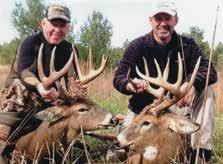

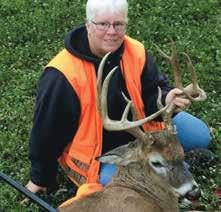
■ Houghton Lake, Michigan, is not known for big bucks. Neither is Beaverton, Michigan, where my son lives. We know which Michigan counties produce most record-book entries, and we were looking forward to the challenge of hunting trophy bucks.

We were switching our hunting efforts to southern Michigan’s farm country when we encountered Ray Scott of the Whitetail Institute at a hunting show in Alabama in the late 1980s. The encounter changed our concept and approach to land management. We learned that food plots would become the backbone of our strategy.
We currently own and lease several farms in southern Michigan counties known for trophy bucks. These farms are planted with Whitetail Institute products, spring and fall. Deer love a variety of food.
fa-Rack Plus, Whitetail Oats Plus, Winter Peas Plus or Tall Tine Tubers (we change annuals from time to time) in remote areas. We mostly use the smaller food plots for bowhunting, but after the pre-rut/rut begins, we switch to much larger food plots (2 to 4 acres) planted with Imperial Whitetail Clover, which attract does and rutting bucks.
■ This buck came into an Ambush field at first light and stood broadside at 50 yards. After I shot, he ran into an Imperial Whitetail Clover field. Thanks!

A deer’s life revolves around food, water, safety and reproduction. We try to cater to all those needs. We also create safe zones we seldom enter, and when hunting pressure increases around our farms, deer know where to go. Three of the food plots on each farm are small (1/4 to 3/4 acre) and are normally planted with Imperial Whitetail Fusion, Al-
The day of this hunt, I counted more than 20 bucks chasing does in and out of the food plot. I knew larger bucks would soon pick up the scent of an estrous doe and follow it to the plot. Then, two bucks came out of the woods simultaneously but separately. I knew immediately both were trophy class. They locked onto a doe, and the chase was on. The lead buck was a big 8-pointer, but the second — and larger — buck attracted my focus. I ranged him at 130 yards and had him locked in my cross-hairs while tracking him to clear a pair of feeding fawns. Boom. The .450 Bushmaster barked, and the results were immediate. The big buck went down within 30 yards of the hit.



Ah, the good old days, when my food plots were the only show in town. Deer galloped into them like heifers let out of a pen for the first time in weeks, gleeful to get at the green food I’d planted. And I patted myself on the back for offering whitetails a buffet when they had few other choices.

I knew it would change, of course, and it has. In most of the areas I hunt, other hunter-managers are now doing the same thing I’ve done for years. They’re planting food and making cover for whitetails, and I’ll admit some of them are pretty darn good. In short, deer have choices now they didn’t have only a handful of years ago. It would be tempting — though unproductive — to pine for times when deer were naive and liked me better than anyone else. Instead, I’ve just learned to get better at what I do. Here are a few tips I’ve learned to make sure I’m — to borrow an old Army recruiting phrase — being all that I can be.
Farmers learn quickly that planting the same stuff in the same dirt every year is tempting but usually counterproductive. Plants have nutritional needs, too, and they draw nutrients from the soil to survive. Although some of those nutrients can be replaced through fertilization, there are other considerations. For these and other reasons, it makes sense to rotate your plantings from plot to plot on a consistent basis. Perennials such as Imperial Whitetail Clover, Fusion and Chic Magnet are obvious exceptions, but in my experience, about the only ones. For the annual lineup, plan on switching seed varieties in your plots on an annual basis or at least every other year for best results.
Let’s assume you have four food plots on your property. I like to have one established in a perennial clover or clover/ chicory blend. Two are devoted to annuals; one for post-rut/late season fare, such as Imperial Winter-Greens or Beets & Greens, the other to a mix more attractive
to deer earlier in the season (Pure Attraction is my favorite). The last is one I’m prepping to convert to a perennial plot. The possibilities for this plot are pretty broad. If it’s a spot notorious for weed growth, I might hit it hard with Roundup in spring and then plant it with something such as Whitetail Oats Plus early, let deer hit it until the oats head out, and then plow those under and plant it in a perennial like Imperial Whitetail Clover or Fusion that fall.
By using this basic rotation, I keep offering something new or different to deer in a variety of plots each year, with an Imperial Whitetail Clover or Fusion plot serving as the anchor for the system. Obviously, I might have properties with room for more than four plots, but I work the same basic system and multiply it by that basic ratio.
Let’s face it: There’s the food plotter we want to be, and then there’s reality. We know we should soil test, fertilize and keep ahead of weeds with herbicides and mowing, and when I go into each food plot season, I have stellar plans and great intentions. And then life happens. Some of our busy lifestyle can’t be helped, of course. If you have one child in soccer, another in softball and a job that eats up 50 hours a week, food plots might (make that should) take a back seat to more important stuff.
Which is why it pays to be honest with yourself when devising a food plot plan. If summers are packed with activity and you don’t have time to tend to the care and maintenance of a clover plot, for example, consider planting an annual. I adore clover plots, which offer essential nutrition to deer for much of the year, not to mention an attraction that’s hard to beat; but they require attention in the spring and summer.
Similarly, if you don’t have the equipment needed for A-to-Z food plot planting (tractors or ATVs and the requisite
implements), don’t give up on food plots. With products such as Secret Spot, BowStand and No-Plow, you can construct a kickbutt food plot with minimal effort and almost zero specialty gear. I know this because I’ve done it sev eral times, especially on properties where it was difficult to haul heavy equipment. It’s easy to convince yourself that if you’re not a farmer — or at least a scaled-down version of one — that you’re out of the food plot game, but it’s not true.
One thing many managers forget as they plant plots is what they plan to offer deer and when they expect them to eat it. The no-brainer answer is, of course, food. But I learned in a hurry you must do better than that. The type of food is critical, as is when you want or expect deer to eat it. All of which can depend on the time of the year and other factors, including cover slope and hunting pressure.
For example, I have a farm with a 30acre south-facing slope, covered with red cedar and burr oak. During the warm months of summer and early fall, that slope is a deer desert. Because of the warm temps and lack of browse, whitetails cannot meet any of their needs in that area, so a plot designed for those times of year is almost pointless. Of course, everything switches when temps take a dive. Suddenly, that deer desert turns into a whitetail oasis, as deer seek out the warmer ambient temps of the southern slope and the thermal cover provided by the dense cedars. So, we plant a winter blend, such as Winter-Greens or other brassica/turnip blends, and deer destroy the plot in the appropriate season.
Conversely, I have an abandoned pasture parcel on one farm that is not close to good cold-weather bedding or security cover. So, I devote plots in this area to early fall offerings, such as clover, Whitetail Oats Plus and other blends, and have had terrific success. Those plots have done more than anything to teach me the importance of studying how deer naturally use the landscape and planning my food plots accordingly.

A premium food plot mix of Imperial Clover plus the added benefit of our exclusive WINA Chicory Perennial — Single planting lasts up to five years Up to 44% protein
Optimum Growing Environment: Soil Type: Moderately drained soils to heavy soils that hold moisture
Soil pH: 6.0-7.5 Sunlight: 4 to 6 hours of daily sunlight
One of the most common traps food plotters fall into is the rush to get things planted in spring and early summer. I know this because I’ve made the same mistake multiple times. In a rush to get plots in as soon as turkey season was finished, my initial optimism often gave way to frustration, as abundant and aggressive weed growth threatened my plot. Of course, there are some wonderful herbicides (Arrest Max and Slay are two of the best) designed to combat this situation, and they work well when applied at the proper time. But because summer is one of my busiest work periods, time crunches often prevented me from jumping on weeds when I should.
Then I discovered the beauty of late summer/early fall planting. With weed germination waning, if not done, competition for space and nutrients let my food plot seed perform as it should, especially with a clover planting. In the past, I’d always wanted to get clover in the ground as early as possible, envisioning a lush clover plot that would attract fall whitetails. What I frequently got instead were clover seedlings struggling to survive among weeds that were off to the races almost as soon as I’d planted. Finally, a farmer/ hunter buddy suggested waiting until August or September.
“Plant your clover with a nurse crop like oats,” he said. “The nurse crop will jump out of the ground immediately and suppress whatever weed competition you might have, and will be attractive to deer, too. Meanwhile, your clover has a great start for next spring, when you really want something green for does ready to drop fawns and bucks starting to grow antlers.”
As is so often true, my farmer friend
was correct. Now I plan all my clover plots for fall plantings, and my success in growing killer clover has skyrocketed. I create better clover plots than ever and do so with less maintenance, lower input costs (as in almost no herbicide application) and almost zero frustration. Of course, the same can be said for annual plantings, and I’ve had solid success waiting until late summer to plant offerings such as Beets & Greens, Whitetail Oats Plus, Winter-Greens and others. Whitetail Oats Plus is also ideal for a nurse crop.
Successful food plotting depends far more on common sense than rocket science. By paying attention to what works in your region and how deer behave on your property, you can get better at planting the right seeds in the right places and making your property as attractive to deer as possible. One thing I wish I would have learned a lot earlier in my food plotting experience was a willingness to ask for advice and to get a second set of eyes on my property. So often, a fresh perspective can shed light on situations that trouble us or offer a solution we hadn’t pondered before. Getting the most out of our food plots and how they fit into our management plans is an ever-evolving process — and one I enjoy tweaking every year.













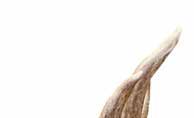








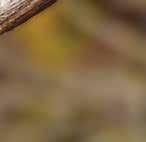






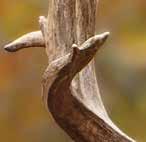
It’s time to put this hot topic to rest — maybe.

DOES
A doe’s genetics and nurturing ability are prime factors determining yearling buck antler size. Maternally experienced does invariably conceive more progeny, successfully raise a higher percentage of them, and tend to raise superior males that ultimately grow the largest antlers.
In recent years, no aspect of whitetailed deer management has caused more debate than the practice of culling to improve antler quality.
Conflicting deer research findings have fueled this controversy.

Culling is the selective removal of presumably inferior deer in order to improve the quality of the remaining population. Among whitetails, the culling harvest strategy generally involves targeting those bucks with inferior antlers for removal to improve overall antler quality of those left to do the breeding and for harvest at older age.
Some researchers claim antler traits are genetically linked and inherited. If so, they say, yearling (1-1/2-year-old) antler characteristics are reliable predictors of future antler quality. In their view, spiked-antlered yearlings are genetically inferior to fork-antlered yearlings and will continue to grow small antlers even at maturity.
Meanwhile, other investigators have shown that genetics play a relatively minor role in antler traits of mature bucks. In their view, true genetic effects are often obscured by a host of other factors — especially nutrition — making it difficult to predict a young buck’s antler potential.
Until recently, the culling debate has been founded almost entirely upon studies using captive deer held at unnaturally high densities and fed high-quality or restricted artificial diets.
Study results on captive deer have produced recommendations ranging from removing all spike-antlered (presumably genetically inferior) yearlings, to complete protection of all yearling bucks regardless of their antler traits.
The practice of culling bucks with small antlers, as a management strategy, originated in Texas during the 1980s. Presumed benefits of such harvesting were based upon penned deer research. These early studies indicated the removal of spike-antlered yearling
bucks not only improved antler quality, but also improved inherent genetic traits for large antlers.
However, while conducting controlled breeding studies of deer from northern as well as southern regions, Mississippi researchers found no evidence that removal of yearling bucks with spike or few antler points improved antler quality. Instead, they argued that yearling bucks’ antlers were more influenced by birth date and nutrition than genetics.
Those favoring culling claim spike-antlered young bucks are genetically inferior, will never attain quality antlers typical of fork-antlered yearlings even when mature, and will contribute to perpetuation of such undesirable traits. In addition, they claim culling will help reduce deer density, thereby improving herd nutrition, as well as removing all
small-antlered genes from the herd.
Although there have been relatively few studies conducted to evaluate the effects of culling on antler quality among free-ranging whitetails, findings from more recent field studies tend to fuel the culling debate.
In Mississippi, researchers found that protection of small-antlered young males — intended to more closely balance adult sex ratios – may inadvertently contribute to smaller than normal antlers in subsequent years on some areas. More specifically, these researchers discovered that implementation of a 4-point minimum harvest rule resulted in a reduction in average antler size among 2-1/2- and 3-1/2-year-old bucks in subsequent years on certain areas.
Hence, although the strategy may have increased the proportion of older bucks in the population, overall antler quality declined. It is important to recognize that antler genetics were not impacted in the process.
Instead, antler size was smaller because of harvest restrictions that protected deer born late in the season. At the same time, many early-born bucks grew 4-point or better antlers, hence they were eligible for harvest. Smaller antlers in older bucks are more likely explained by excessive harvest of young bucks with the largest antlers when they were yearlings.
The best data indicate that yearling harvest rates of less than 50 percent are not likely to impact subsequent cohort antler characteristics. Likewise, protecting young males with small antlers
Brillion Farm Equipment offers a full-line of equipment suited for food plot enthusiasts. The Food Plot Seeder is an all-in-one solution for food plots handling seedbed preparation, seed metering and placement, as well as seedbed finishing. Brillion’s ground driven Till ‘N Seed® shreds existing food plots and plants numerous food plot seed mixtures. All products are backed by Brillion’s years as an industry leader in the Seeder and Pulverizer industry!




should be viewed as a temporary solution to chronic age-structure problems.
Although their findings have been challenged, studies conducted in Texas showed that a whitetail buck’s first set of antlers was a poor predictor of antler growth at maturity in wild populations. In other words, selective removal of small-antlered yearling bucks will not increase overall mature buck antler size.
Bucks that started out with 3 or less antler points remained smaller in all measured antler traits at 2-1/2 years of age and in most antler traits at 3-1/2 years of age. However, by 4-1/2 years of age there were no differences in any antler measurements regardless of their yearling antler-point category.
Although antler measurements increased for all males as they matured, small-antlered yearlings added antler mass at a faster rate in succeeding years, as compared to large-antlered yearlings. This resulted in no difference in antler
size, regardless of their yearling antler size, by the time bucks grew their fourth set of antlers when 4-1/2 years old.
Hence, in this particular study, yearling antlers did not serve as a reliable predictor of antler growth potential, meaning selective removal of yearling bucks with small antlers is not likely to improve overall mature buck antler quality.
Recent published findings by David Hewitt and a group of Texas A&M researchers may have finally answered this rather intriguing question: Do yearling antlers serve as a predictor of antler growth potential? These researchers used capture and harvest records from an impressive sample of 2,940 male whitetails on five study sites in Texas over a 10-year period to track antler development among bucks from yearling age to 5 years of age.
In their study, yearling deer with 3 or fewer antler points had antlers at ma-
turity that were 32 centimeters smaller (on the Boone and Crockett scale) than deer with 4 or more antler points at yearling age.
According to Hewitt and his cohorts, “Our data shows clearly that yearling male deer with small antlers have, on average, smaller antlers at maturity.” In their view, “the correlation between yearling and mature antler size was unequivocal.”
As expected this latest study found that yearling body size was positively related to yearling antler size. This suggests that yearling deer with small antlers may have experienced poor nutrition early in life. However, the relationship between yearling antler size and body size became weaker at older ages. As a result, this suggests that deer have compensatory growth capability in body size or that factors other than early life nutrition have a greater influence on body size in older deer.
Since whitetails exhibit segregation of the adult sexes, this also implies that
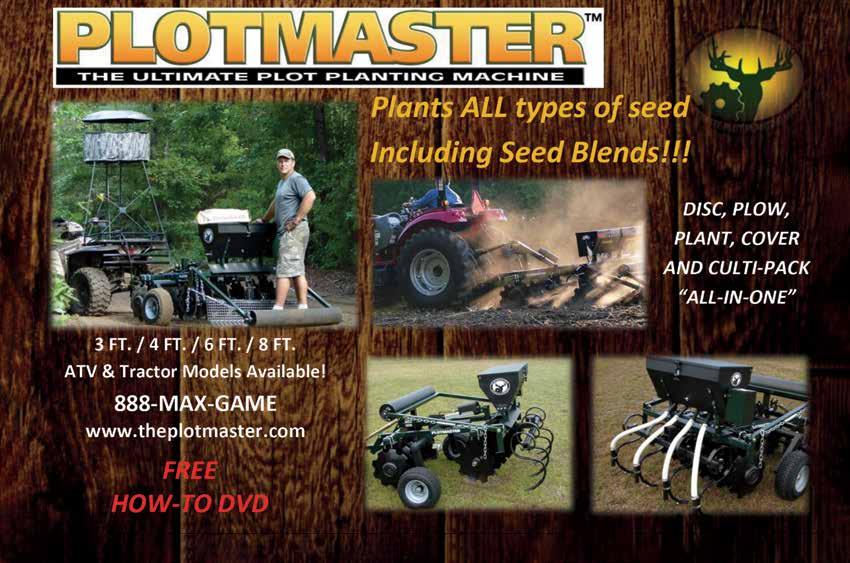
habitat management designed to favor one sex may not necessarily favor the other. Obviously, nutritional conditions on the fawn’s natal range are critically important, as growth and development at a young age will impact the deer’s development throughout life. This does not mean antler genetics are unimportant. But this is a complex subject deserving far more discussion than allowed here.
Given their study findings, the authors conclude the following: “Because of a positive relationship between yearling and mature antler size, selective harvest of juvenile males can either increase or decrease average antler size of the cohort, depending upon harvest criteria.”
Managing antler genetics is difficult,

and the selective harvest of yearling bucks based upon antler size can yield potential consequences. In my view, there are many factors that can impact a yearling buck’s physiology, quality of life, and ultimate physical development. Seasonal variations in climate, nutrition, deer population structure, density, birth date and nurturing are far more important than genetics in determining the quality of a young buck’s first set of antlers.
Remember, antlers are secondary sex characteristics and that body growth takes precedence over antler growth. Invariably, the healthiest and largest yearling bucks will carry the largest antlers.
Also, the doe’s genetics and nurturing ability are prime factors determining yearling buck antler size. Maternally experienced does invariably conceive
more progeny, successfully raise a higher percentage of them and tend to raise superior males that ultimately grow the largest antlers. That’s especially true when compared to younger does that are nutritionally or socially stressed.
If the management goal is to raise large antlered bucks, my advice is to concentrate efforts on habitat improvement to best meet the whitetail’s seasonally changing nutritional needs, while controlling herd density and sex/age composition to assure that bucks achieve maximum size at maturity.
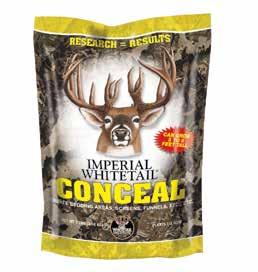





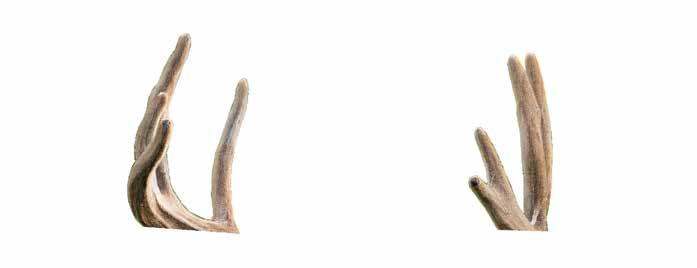
Brandon Thome-Neitzel was in a quandary. He went into the 2020 Wisconsin archery season with his eyes on a 160-inch 10-point buck that would be his biggest whitetail with a bow. However, a monstrous 150-class 8-pointer regularly visited his Imperial Whitetail Clover food plot.
“I really had my sights set on that 10-point,” Thome-Neitzel said. “He was just under my skin, to the point that the first several hunts of the 2020 archery season, I passed shots on the 8-point as I waited for the 10 to give me a shot.”
Whether he recognized a classic bird-in-the-hand scenario or realized how great a deer the 8-pointer was, Thome-Neitzel eventually had a change of heart.
“The evening of Sept. 25, a full half-hour before quitting time, the big 8 came out in that clover plot like I’d watched him do so many times before,” he said. “This time, I had the bow in my hand, and when he gave me a standing shot at 55 yards, I took it and made a perfect shot.”

Thome-Neitzel clearly made the right decision in arrowing the buck. The Badger State giant topped the scales at 275 pounds (live weight) and pushed the 150-inch mark as an 8-pointer. Anyone familiar with Boone & Crockett scoring recognizes what it takes for a 4-by-4 to achieve that score.
Although a fantastic trophy in its own right, Thome-Neitzel’s buck served as an even more satisfying indicator of a management plan that had transformed a so-so property into a whitetail mecca.
Wisconsin is noted for producing trophy-class bucks (it currently leads the Boone & Crockett and Pope & Young books in total entries) for years, but many of those mature animals came from a handful of counties. Adams County, in the central part of the Badger State, was not one of them.
“When my dad bought this property in the late 1980s, big bucks were not on our minds,” Thome-Neitzel said. “In fact, that first year, someone killed a spike buck, and they were in seventh heav-
en. They’d killed a buck on property Dad owned, and that was more than enough.”
For several years, the family enjoyed the property as it was, but as their knowledge about whitetails and their food and habitat needs increased, they began slowly transforming the acreage into a place that outperformed its origins.
“There was a time when a basket-racked 8-pointer was about as good as you could hope to do,” Thome-Neitzel said. “Then we just learned more and worked harder, and things started to turn around. The last five to 10 years, we have really noticed a big difference.”
As noted, the transformation of their parcel was not immediate, requiring significant investments of time, money and sweat equity. But the wait has been worth it. Here’s a look at some of the most significant steps the Thome-Neitzel crew has taken in turning a decent piece of deer ground into a whitetail paradise.
Wisconsin sports some pretty fertile farmland, perfect for growing bounteous row crops or food plots. Unfortunately, the family acreage didn’t have that type of dirt.
“It’s pretty sandy soil,” Thome-Neitzel said. “We literally put in tons and tons of lime and fertilizer every year, trying to get the proper pH. And we soil-test every plot every year. It’s a lot of effort, but let’s face it, it’s garbage in, garbage out on pretty much anything related to deer and land management. Your rewards are the result of your efforts.”
The property has several food plots of varying sizes.
“We really try to offer deer a buffet of plantings,” Thome-Neitzel said. “I think it’s important to have a variety, because deer needs and preferences are changing all the time.”
Thome-Neitzel’s 2020 buck was a frequent visitor to an Imperial Whitetail Clover food plot, and he said the buck was not the first to exhibit such behavior. More important, he stressed, was the time of the season his hunt occurred.
A Wisconsin family proves solid management and long-term goals are worth the effort.PHOTO COURTESY OF BRANDON THOME-NEITZEL

a staggered effect. It really made a difference in the habitat on the property and was one of the best things we’ve done.”
The crew also plants trees, which has

helped the property.
“Each year, we buy about 600 trees and plant them on a weekend,” Thome-Neitzel said. “Some people think planting that many trees primarily for deer is a little extreme, but for us, it’s all part of the journey. It’s pretty neat seeing how the trees have grown over the years and the impact they’ve had. Sore hands are a small price to pay for having adequate food and cover for the coming years.”
Another critical element of the Thome-Neitzel management plan has been the installation of waterholes on the property.
“We have eight small ponds and one large one scattered across the place,” Thome-Neitzel said. “They’ve been a key to attracting and holding deer here. We have an archery stand by most of them, and they produce a lot of action for us.”
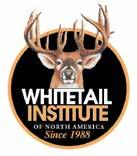


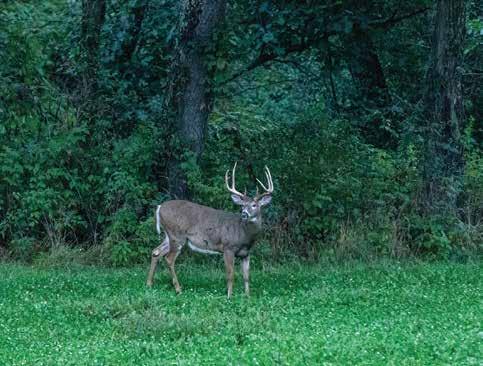
Thome-Neitzel said they typically construct a pond with a rented mini-excavator.
“We try to put them in places where the water flows naturally already,” he said. “We dig them just a few feet down and build up the sides, and then use a skid steer loader to smooth out a couple of spots so they can only enter from an area that presents a shot opportunity.”
To ensure the pond holds water, Thome-Neitzel stressed the need for a liner.
– IMPERIAL CLOVER PLOT ATTRACTS Here’s Thome-Neitzel’s monster buck standing in a field of Imperial Whitetail Clover.“We’ve experimented with Bentonite, which some guys have really good success with, but I don’t prefer it in this area,” he said. “Instead of forming a hard seal, it gets kind of mushy and gooey. We’ve had better luck with heavy-duty rubber roof lin ing that we stretch across the bot tom and then backfill over. My dad and I are in the heating and air conditioning business, and we know a lot of guys in construction. So I have a couple of guys keeping an eye out for sections of this we can get for cheap or free.”
Although his group has enjoyed enviable success, Thome-Neitzel believes the keys to starting and maintaining a whitetail paradise are the desire and patience to create something better than what you had, combined with a continual willingness to learn.
“One of the first steps is just recogniz-

Includes the only clovers ever scientifically developed specifically for food plots for white-tailed deer

Perennial — Lasts up to five years from a single planting
High protein; heat-, drought- and cold-tolerant; disease-resistant.
Soil Type: Good quality, heavy soils that hold moisture (a/k/a “bottomland” soils).
Avoid lighter or sandier soils, and sites that drain quickly.
Soil pH: 6.5-7.5

Sunlight: As little as 4 hours of broken, filtered, or indirect sunlight a day
• Can be planted in spring or fall
ing that you don’t know as much as you think you do,” he said with a laugh. “We listened to the advice of other people who knew a lot about whitetails and their food and habitat needs. And like a lot of serious whitetail guys, we recognized that hunting is just one part of the year, and we’ve found doing the hard work the rest of the year is just as important — and actually a lot of fun.”
Finally, Thome-Neitzel emphasized the need for patience and setting realis-
tic long-term goals. “Everything is a work in progress,” he said. “If you’re expecting immediate results, or that the first thing you try is going to work, you might be disappointed. We’ve found the things that worked the best sometimes took a while. But when we look back at where we started, it’s a night-and-day difference from where we began.”
Whitetail antlers entrance us. However, the process by which they grow might be more fascinating.
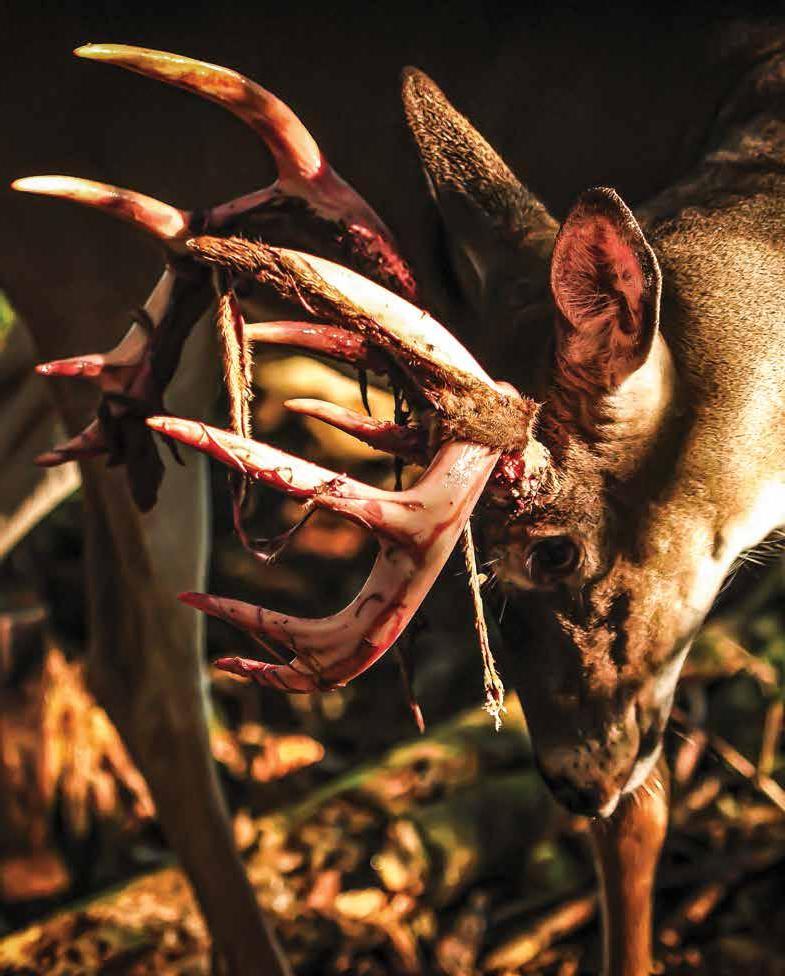
Certain things have an uncanny ability to reach our psyche and produce an infatuation that’s mesmerizing and fixating.
For some, it’s the open ocean, a world where the water and sky meet. For others, it’s the majesty of a towering mountain that fills the spirit yet makes you feel very small. Then, of course, there are antlers. Some of you might think I’ve missed the mark by comparing oceans and mountains to antlers. But I have not, unless it’s because antlers grip the mind even more. Think about your reaction when a huge-antlered buck steps from the edge of a food plot or emerges from a brushy draw. Your heart and breathing rate soar, and your blood pressure spikes. You immediately throw up the binoculars to look, and if you’re not careful, the rack entrances you so much you forget the years of training and experience and collapse into a pile of antler-crazed mush. I have many stories of dropped gloves, fumbled bow releases and internal shakes so severe they register on the Richter scale. And it’s not just me. Watch any hunting show and you will see “professionals” fall to pieces when antlers appear. Sometimes, manly men break down in tears when they grasp the antlers. That’s happened to me, too. Some might call this buck fever, but I call it antler neurosis. I don’t know where it comes from or the mode of action, but it’s real. Aside from their psychological effects, antlers are scientifically fascinating. Their fundamental purpose is as a weapon for the battle of procreating the owner’s genetics. Antlers are also a good indicator of the health and nutritional plane of specific bucks and the herd in general. However, I think the most interesting aspect of antlers is the mechanism by which they grow.

The antler growing cycle is controlled by the endocrine system via varying hormonal levels that occur during various times of year. Deer are known as short-day breeders, which means does will cycle and the rut will commence during the time of year with fewer daylight hours. With decreased daylight
comes an increase in melatonin production, which triggers responses that eventually result in increased testosterone production. That drives bucks to start searching for, chasing and breeding does. But testosterone plays far more roles than simply breeding. If you follow the testosterone levels in a buck’s system throughout the year, you will see a slight bump around early spring, which is the catalyst for regenerative cells in the pedicle to begin antler growth. Testosterone levels then decrease slightly but begin to slowly increase in late summer and early fall. Testosterone levels reach a point in early fall that will cause velvet to be shed, revealing the hardened antler. Then those levels peak during the rut and begin to decline. When levels decrease enough, bucks shed their antlers, and then the process restarts. You have probably heard of cactus bucks or bucks that never shed their velvet and continue to grow antlers, albeit abnormal in appearance. Those bucks start antler growth, but then something, such as injury to the testes, does not allow testosterone levels to increase high enough for velvet to shed. Also, research has shown that if deer are artificially enhanced with testosterone, they won’t shed hardened antlers until the testosterone treatments are discontinued.
Most people think of antlers in their hardened state, but during most of the antler growing cycle, antlers are growing, living things. When testosterone triggers antler growth to restart, antlers begin as a bump or bulge on the pedicle. For a few weeks, it appears that not much is happening, but the regenerative pedicle cells are laying the early antler foundation. The outside of the young growing antler is covered with a skin-like tissue called velvet, which is comprised largely of blood vessels that feed nutrients to the growing antler underneath. In fact, there is so much blood flow that velvet can actually feel hot. Velvet is also extremely sensitive, causing bucks to treat growing antlers quite gingerly. That helps prevent the velvet from being injured during the growing cycle, which would negatively affect antler growth for that cycle.
As the antler begins to extend and grow, a structure begins to form under the velvet that constitutes the framework of the antler. This is a protein matrix comprised primarily of collagen and gives the antler its basic shape. In the early growing stages, antlers are mostly protein — about 80 percent. As the collagen matrix grows, minerals are deposited within the matrix as the first steps of mineralization. The mineralization, or hardening process, speeds up in late summer, with more mineral deposited on the internal protein framework. As mentioned, mineral is transported to the growing antler via the blood flowing through the velvet. You might think this mineral comes directly from the deer’s diet, but it actually comes from the skeletal system. Minerals — such as calcium, phosphorus and magnesium — are taken from the skeletal system and transported to the antler in similar fashion as
mineral transport for lactation. Antler growth is secondary to skeletal health, and a buck’s body will not compromise skeletal health for bigger antlers. When velvet is shed in early fall, it reveals an antler structure that is about 55 percent mineral and hardened to the consistency of dry bone. The comparison to bone is appropriate, because antlers are essentially bone — an external extension of the skeletal system.
Antler growth is affected by many factors, but the three main players are genetics, nutrition and age.
Genetics has been a hot topic among deer hunters for years, and it undoubtedly affects the ultimate potential of antlers. After all, deer breeders use genetic selection to grow antlers larger than anyone thought possible. When trying to manage genetics in a wild deer herd, how-

ever, there are multiple problems. First, you can’t control which bucks breed. You can try to remove what you perceive as bad genetics, but you will likely not remove all of them. Also, the perception of bad genetics might not necessarily be reality. You might see a spike yearling and think, “Cull him.” However, it might be a late-born fawn, or the doe had subpar milk production. Possibly, there was a drought that year, and the nutritional plane was deficient. Those bucks might have good genetics but don’t display them phenotypically because of outside influences. Of course, there’s the obvious issue of only being able to manage half the equation. Theoretically, does should supply half the genetics, and there’s no way to determine in a wild herd if a doe has good or bad genetics when it comes to antler growth. I’m not saying there isn’t merit in culling mature bucks that are obviously inferior, but simply trying to rely on that tactic will likely lead to disappointment.
Age is another critical factor and one you must try to manage if you want to maximize antler growth. You will have no idea about the potential antler size of a buck until he reaches maturity. From birth until about 3 years old, bucks grow their skeletal and muscular system. That growth takes precedence over secondary functions, such as antler growth, so nutrients are directed first toward body growth. At 3, bucks reach skeletal maturity, and at 4, they reach muscular structure maturity. You often see a sizable jump in antler size between ages 2 and 3 and then again from 3 to 4 because more nutrients can be directed toward antler growth.
At 5, bucks have reached full maturity and have had an entire antler growing cycle during which nutrients can be directed in larger quantities toward antler growth as opposed to body growth, which is why you typically see the largest antler size at 5 and 6.
Biologically, a buck simply cannot reach full antler growth potential until they have reached body growth maturity. Think of it this way: Like many teenage boys, I could eat about anything and never add to my waistline because I was growing muscle and bone. Then at some cruel point, I hit my growth maturity, and that half a large pizza went straight
to my gut. If waist measurement were the equivalent of Boone and Crocket antler scoring, I didn’t reach trophy class until I matured. At least that’s what I tell my wife.
Genetics and age are fixed antler growing factors, and nothing can be done to change a buck’s genetics or speed up maturity. The variable factor we can influence is nutrition. Look at it from the perspective of building a house. Genetics are the blueprint for the house and cannot be altered, as you can’t make the house bigger with the designs you’re given. Age is the time it takes to build the house, and if you stop building — that is, kill a buck —too early, you will never complete the house. Nutrition equates to the materials used to build the house. To build the house to its full potential, you must have all the materials. If you are short on lumber, shingles and flooring, you will never achieve what the blueprint could have produced.
In most cases, nutritional management will show dramatic increases in antler growth because nutrition is a lim-
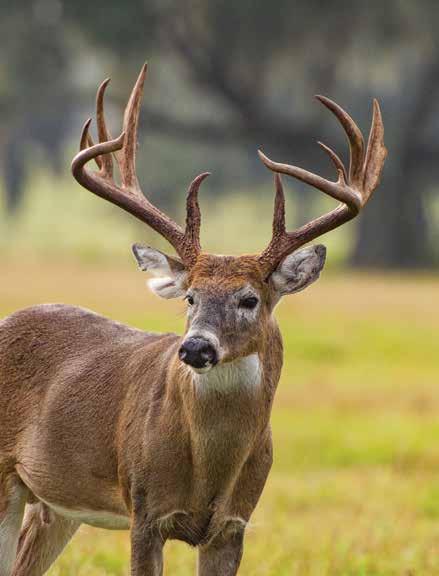
iting factor, even in agricultural regions. For example, Iowa has abundant corn and bean fields, but those are not present year round, and there might be mineral limitations in the soil. Regardless of your location, nutrition is limited if you’re trying to maximize antler growth.
The critical consideration involves maximizing antler growth. Deer can survive without nutritional management, but will they reach their genetic potential? In almost all cases, they will not without supplemented nutrition, which is why nutritional food plots and mineral supplements produce positive results regardless of the region. Nutrition is the broader terminology for all nutrients a deer consumes. Although all nutrient categories are important for antler growth, protein and mineral are often the focus because they tend to be the most limiting naturally in the diet during the antler growing phase, and both are prominent players in antler growth.
But it’s important to understand that nutrition is a year-round management

consideration. Just because we hang up the bow and oil the gun for winter storage doesn’t mean deer quit eating. Health and body condition also take priority over antler growth, so a buck must be in top physical condition to have the chance of maximizing antler growth. Nutritional deficiencies change based on seasonal nutritional needs and nutrition availability, so year-round nutritional management practices for optimal antler growth are best.
Antlers have a mysterious quality for most deer hunters. Maybe they symbolize hunting prowess or represent the unique grandeur of the deer. Or perhaps it’s just cool to have a big set of antlers. Either way, it’s real. But when you look at the science of how and why antlers grow, you realize an even deeper respect for them and what they represent.

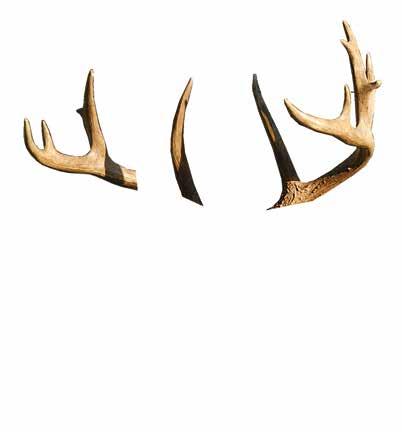
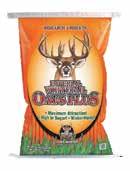
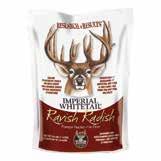

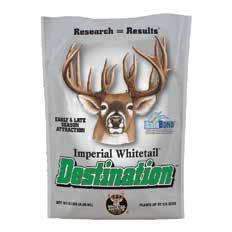
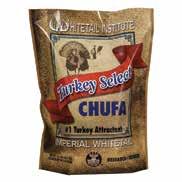




Amassive-bodied, chocolate-antlered brute eases out of the timber, pushes through thick early successional cover, and emerges in a lush, green clover plot. The sound of beheaded Imperial Clover echoes throughout the plot. As the buck raises his head to survey the landscape, threeleafed forage falls out of his mouth with each movement of his jawbone.
If there’s ever been a more beautiful sight, I haven’t seen it, and I’ve been to the beach — a lot. There’s nothing better than watching a whitetail benefit from a food plot you created, and filling a tag on a mature buck over a plot the epitome of the experience.
Clover has been around for thousands
of years, but hunters have been planting it for deer for decades. Clover is king in the world of food plots, and there are many reasons why. Whitetail Institute Director of Operations Brandon Self shed some light.
“Once it gets established, it’s very hardy,” he said. “And really, as far as palatability, it’s hard to beat clover with a good pH. If fertilized right, it’s the best perennial food plot you’re going to get.”
A legume, clover is a great food source for deer and also helps the soil by putting nitrogen back into the ground. The process involves pulling this vital element from the air and transferring it to the soil. In this regard, inoculated seeds improve efficiency. Nitrogen-fixing bacteria attach to the roots, forming nodules. That’s where the conversion process occurs.
Legumes such as Imperial Clover are the food plot species that do this.
Even without the soil-care benefits clover provides, high protein and palatability levels make it a no-brainer. Clover is king in the world of man-provided deer foods.

Like all things, being prepared is critical, and procrastination is clover’s worst enemy. Take soil samples long before planting. Having a good pH increases nutrient-uptake efficiency, resulting in bigger, healthier plants. If nothing else, contact your local ag extension agency for assistance.
Of course, planting clover can be as simple or complex as you like. But regardless of your experience or goals, you
should follow certain steps to get the most from your Imperial Clover plots.
“Don’t just go out and get fertilizer,” Self said. “Get as close as you can to the fertilizer recommendations that are on the soil test.”
After you’ve sent off the soil sample, start preparing the ground. This should be done weeks before planting day.
“Don’t wait until the day before you’ll plant to start breaking ground,” Self said. “The more in advance you prepare the ground, the more weed-free it will be, and the more your seedlings will be able to grow without competition. The earlier you can break ground, the more weed seed you’ll turn up to germinate. Then, you can till it again. So, the earlier you prepare ground, the better.”
Then, when you’ve worked up the ground a time or two and weeds are handled, apply the recommended fertilizer called for by the soil test results. Generally, the desired pH level is 6.5 to 7.0. After you apply the fertilizer, lightly disc or till the ground a final time, and then culti-
pack it. The seedbed is prepared.
Whether using a hand-crank or motor-powered broadcaster, make sure seeding rate settings are correct. You don’t want to spread clover too thick or thin. Also, never forget how small clover seeds are.
“Don’t plant seeds too deep,” Self said. “Really, plant it on top of the ground, and no more than 1/8-inch deep. If you have a cultipacker, the best way to plant clover seed is to cultipack the ground after the ground is prepared, clean and ready to go. Then, broadcast your seed, and cultipack it one more time.”
That’s all it takes to grow a great clover plot. Of course, you can take steps to boost yields and usability.
Folks who wish to take their clover plots to the next level should also think about other aspects, such as advanced fertilizing tips, increased weed control and fine-tuning planting dates. It sounds repetitive and cliché, but taking soil

samples and applying the exact fertilizer and lime needed does more than ensure growth. It also improves palatability and the sweetness of the plant. Deer recognize those things and will target the clover more or less accordingly.
“Maintaining your soil pH throughout the year will ensure a healthy, productive and high-yielding crop,” Self said.

Weed control is another advanced practice. Starting this process early enough decreases competition in the long term.
“A lot of people try to kill weeds that are mature and hard to [terminate],” Self said. “The earlier you spray young weeds, the better control you will have.”
Arrest Max is great for grass control. Spray the plot when grasses begin to grow. Slay gets the job done on broadleaf weeds. Plus, periodical mowing helps knock back unwanted plants, too. Do so anytime you see undesirables outpacing the clover, especially when they begin to produce seed heads. Mow just low enough to prevent the flowering process.

Overbrowsing is something else to con-


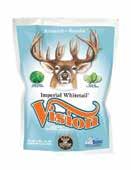
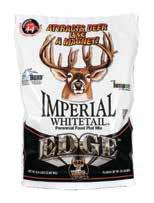
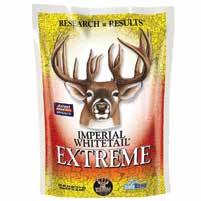
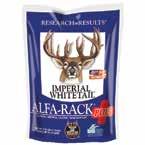


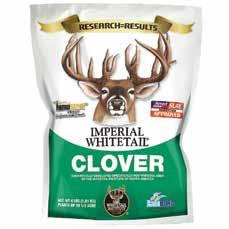



sider. In areas with lower deer densities, spring planting is usually best. However, if you’re worried about overbrowsing, fall often offers certain advantages (whitetailinstitute.com/whitetail-clover-planting-dates/).
In areas of low to moderate deer populations, Self encouraged food plotters to plant in spring. This isn’t conducive to all areas of the country, he said. But if you plant a perennial clover in spring, the weather is right and you conduct proper ground preparation, you should have more growth for the fall hunting season.
Spring seeding doesn’t come without unique challenges, though. You have more weed competition to deal with by planting in spring and summer.
“But if you fall plant, you don’t have as much growth as when you plant in the spring,” Self said.
So, there are obvious tradeoffs. Still, for some people, that might be the best option. Some locations have high deer densities, and overbrowsing is a problem. You can combat that, even if you don’t
have electric exclusion fences.
“If you have a really high deer density, and they get on it, it’s not going to really matter if you spring or fall plant — they will overbrowse it,” Self said. “But you can use a cover crop easier in fall, like oats or brassicas, to keep them from overbrowsing while it’s getting established. If you fall plant, you can use Whitetail Oats. They’ll eat the oats while the clover establishes.”
Overall, if browsing pressure is high — especially on micro plots — Self encouraged the use of more variety. Instead of using clover by itself, perhaps add some Fusion, which has chicory and adds overall tonnage. That should help mitigate browsing pressure.
Some food plotters mistakenly think all clover seeds are created equal. That isn’t true. Imperial Clover (whitetailinstitute. com/imperial-whitetail-clover-perennial/) raises the bar.
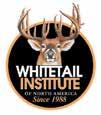
“The biggest reason is the many years of research and development of seed to


establish great palatability, high protein levels and more drought resistance than other clovers. Our RainBond seed coating pulls ground moisture to the seed to promote seedling vigor and quick germination.”

Genetically designed for whitetails, this seed offers increased protein levels, which enhances antler, bone and muscular growth. It also benefits does and helps them maintain and add bodyweight during pregnancy, and produce more milk when fawns arrive.
Further, quicker germination can make great differences in success or failure.
When established, Imperial Clover can last up to five years from one planting, especially if it’s properly monitored and maintained.
■ The past eight years, my brother and I have used almost all of the Whitetail Institute’s products.

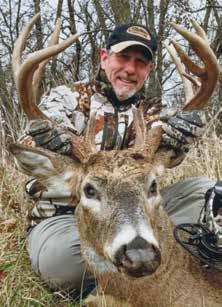

At first, I was new to the food plot game, which led to major growth of grass and weeds in my plots. Noticing the weed growth, I took soil samples, brought my pH levels to where they needed to be and sprayed herbicides. Soon, I planted a 3/4acre plot of Alfa-Rack Plus and a similar-sized plot of Imperial Whitetail Clover. The only problem I had then was too many deer and not enough acreage of plots.
My brother Kevin decided to join in, and he prepared a 1-acre plot, half in Imperial
Extreme and half in Tall Tine Tubers. That year, I expanded my food plot by adding an acre of Imperial Winter-Greens. Each plot we’ve planted is doing well. During winter, I have watched deer paw Tall Tine Tubers out of the snow.
This past season was kind to us in West Virginia. My brothers and I have taken some of the nicest bucks ever shot on our family farm. I want to thank the Whitetail Institute for the great products and what they have done for my family and me.
■ I shot this buck with my bow over one of my Imperial Whitetail Clover fields this past fall. Imperial Whitetail Clover has been a great product for attracting and holding deer on my property for 10plus years. They even dig through the snow to get to it.
■ Family and friends hunt my family’s 180-acre property in eastern Ohio. We planted Imperial Whitetail Clover and Imperial Winter-Greens to attract more deer. A doe slipped out of the woods about 40 yards from me, and the buck attempted to cut her off. Fortunately, he turned broadside and stopped at 35 yards. I let the arrow fly, and he never made it out of the Winter-Greens.

Feb 5 - Mar 1 North: Sept 5 - Nov 15 South: Sept 25 - Nov 15
Feb 15 - Apr 1 Sept 1 - Oct 30
North: Sept 15 - Nov 15 South: Sept 25 - Nov 15
Feb 1 - Mar 1 Coastal: Sept 25 - Oct 15 Piedmont: Sept 1 - Oct 5 Mountain Valleys: Aug 25 - Oct 15
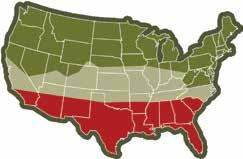
North: Sept 25 - Nov 25 South: Oct 5 - Nov 30

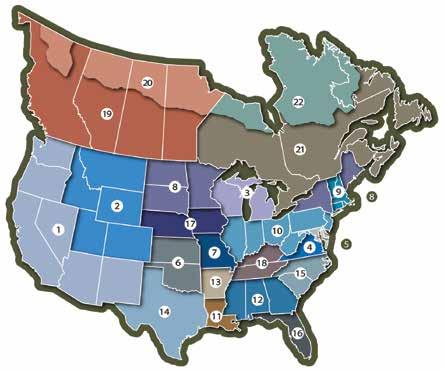
Mar 1 - May 15 Aug 1 - Sept 15
Feb 1 - Apr 15 Aug 20 - Sept 30
Apr 15 - June 15 July 1 - Aug 15
May 15 -July 1
May 1
July 1 - Aug 15

My youngest brother, Adam, had a conundrum — two young sons who love deer hunting and only one dad to take them. The solution was easy in our hunting camp’s eyes: One of us would take the older child, Max, who was 12 years old.
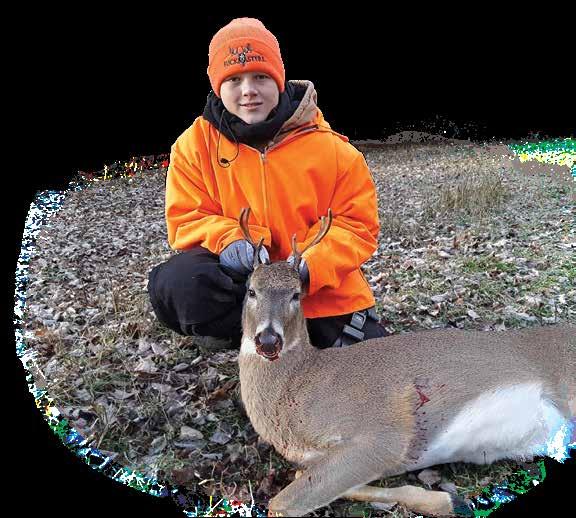
We had others who offered to take Max, but I insisted I be the one. At 53, I was the oldest option. That sort of saddens me! But, moreover, I have had the opportunity to take many good bucks and knew it was time to help keep a young hunter interested in our great sport.
Max is tall for his age, and has an easy going, pleasant personality. I don’t get to spend that much quality time with him, so I looked forward to that. I also realized that it would be fun to pass along some of the woodsmanship I’ve learned chasing whitetails these past 40 years.
“I woke up in the morning barely able to get up but in spite of that I got up and ate some cereal and got suited up for the hunt. I got in the car with my Uncle Bart and we chatted on the way to our hunting land,” Max explained. “Once we got to the hunting land, we got on our orange
tree stand we would be hunting in and climbed up. Once we got up the tree and we were strapped up we pulled up the gun and the hunt began.”
It wasn’t my whitetail knowledge that came to the fore as dawn broke. There were a few turkey hens that started tree yelping less than 100 yards away from our red oak tree. Max gave me an inquisitive look, so I whispered that these were turkeys still on the roost. He said he hadn’t heard that sound so close to him before. We spent the next 30 minutes having the hens chime in with their raspy yelps. We even heard a few unenthusiastic gobbles from a Tom.
As the turkeys settled down and quietly walked away, a few shots rang in the distance. Thankfully, it wasn’t too cold or windy so we both were comfortable as we waited for an opportunity to bag Max’s first buck.
“The turkeys to our left were being very loud for our first half hour or so, and once they stopped, I began to fall asleep,” Max honestly quipped. “I woke up a few times and then my Uncle Bart woke me up and I watched as a nice buck walked into view.”
any hurry as it munched on the clover, so I coached Max to take his time and wait until the deer was broadside.
“I got my gun ready, aimed, turned off the safety, and squeezed the trigger. The buck dropped right where I shot it,” Max said. “I was very proud with myself because I made a good enough shot to drop the buck where it stood. I couldn’t stop smiling because of my accomplishment.”
We waited a few minutes, and it was obvious as I peered through my binoculars that this deer had expired. I also knew that Max wanted to get his hands on his first-ever buck. So, we carefully descended the ladder and walked towards his buck. We field dressed the deer, took a few photos and started walking back towards the stand. I asked him if he wanted to keep hunting or go back to the cabin and warm up.
“No, Uncle Bart, let’s go back to the cabin,” he said with a wide grin. “I’m satisfied.”
So was I.

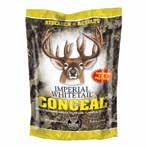





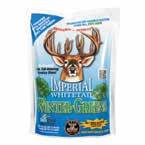
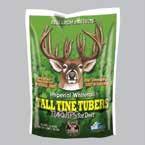




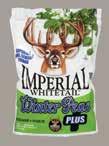
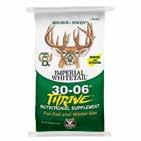



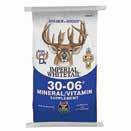






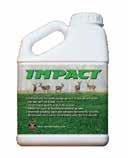
You’ve probably heard of positive visualization, a mental process through which we can achieve better real-world results via what are basically happy daydreams.
I’m a believer — to a point. I’ve also learned that life’s curveballs and Mr. Murphy’s immutable law often derail the power of positive thinking.
Which brings me to deer season. The 2020 firearms hunt promised to be good, as I’d captured several great bucks on camera during fall and had enjoyed a couple of close encounters in archery season. Wanting to be prepared, I’d forged what I considered a solid plan and backed it up with optimistic musings. I’d be out early, hoping to avoid bumping deer using the food plots. I’d slip in quietly and wait patiently, knowing at least one of the bucks I’d seen would probably cruise through a hot funnel atop the ridge. And at the moment of truth, I’d calmly and efficiently seal the deal.

And initially, the plan worked seamlessly. In the pre-dawn blackness of opening morning, I eased the UTV out of the garage and zipped along the edge of the timber bordering a lush clover field. Then, at the fence line, I cranked the wheel hard and prepared for the slow climb up a steep half-mile logging road that led to the ridge top. There, I planned to ditch the buggy and slip undetected into a box blind.
Until the headlights intervened about halfway up the hill. Well, it wasn’t actually the headlights. They just revealed the massive oak that had fallen across the logging road. And although I kept the beams trained on the tree, they didn’t reveal any solutions.
Dang it. The road had been clear just the week before. And friends and I had spent much of summer removing many obstacles from the road to facilitate travel. Why now?
This was a pickle. I obviously couldn’t drive my UTV through the dead timber ahead, but the steep grade of the hillside and narrow contours of the logging road prevented me from turning around. So, there I was, stuck at almost a 45-degree angle at 5 a.m., unsure of how to proceed and more than annoyed at how my plan was unraveling.
Then it hit me. I vaguely recalled a passage from a Kurt Vonnegut novel in which a spaceship descends into a tunnel but cannot go farther. One of the pilots looks out the window and sees a message: “It’s an intelligence test.”
“Of course, dummy,” I thought. “The only thing I can do is back the buggy down the road in reverse.”
Which I wouldn’t even attempt in the dark. So, I initiated Plan B, which involved grabbing my gear and hoofing several hundred yards up the slope to the blind. Not wanting to break a sweat, I stripped to my base layers of clothing and took my time during the ascent, pausing whenever I felt my brow get hot. And when I finally reached the top, I was still a sweaty mess.
“So much for scent-free hunting,” I thought, climbing into the blind. “Hopefully, the wind cooperates.”

Only one doe interrupted my vigil that morning, and doubt began creeping into my mind. Moreover, at about 9 a.m., I faced another forehead-slap realization: If I were to back the UTV down the road
during daylight, I’d have to leave my stand, budget at least an hour for the process and then hoof all the way up the logging road again for the afternoon sit. But having no other options, that’s what I did.
At about 2 p.m., the process complete, I settled back into the stand, sweaty again but perhaps foolishly anticipating the evening sit. Maybe the Good Lord took pity on a fool that day, or perhaps dumb luck just intervened, but I saw 13 deer that night, including a dandy shooter 8-pointer. (I didn’t kill that buck, but that’s another story.) And when darkness fell, I began the long walk down the ridge feeling pretty good about the day.
I could say something corny about how those events, hunting and land management are metaphors for life — about how the journey never really ends, and how we must simply navigate our best through the inevitable twists and turns, triumphs and disasters. Then again, it might be best to take the experience at face value and simply chuckle at how a bumbling hunter had to sweat his tail off during gut-busting hikes and back a UTV down a treacherous logging road as every buck in the township watched from their beds. I’ll leave the determination to you.
Ultimately, it’s a humorous memory. But the story isn’t finished. The tree is still there, taunting me every time I climb the bluff. If anyone wants to help, I plan to grab some chainsaws and take care of it after the snow melts. And if we succeed, we can take the UTV down the hill in drive instead of reverse.
Optimistic plans can fade quickly when facing immovable objects in the dark.


